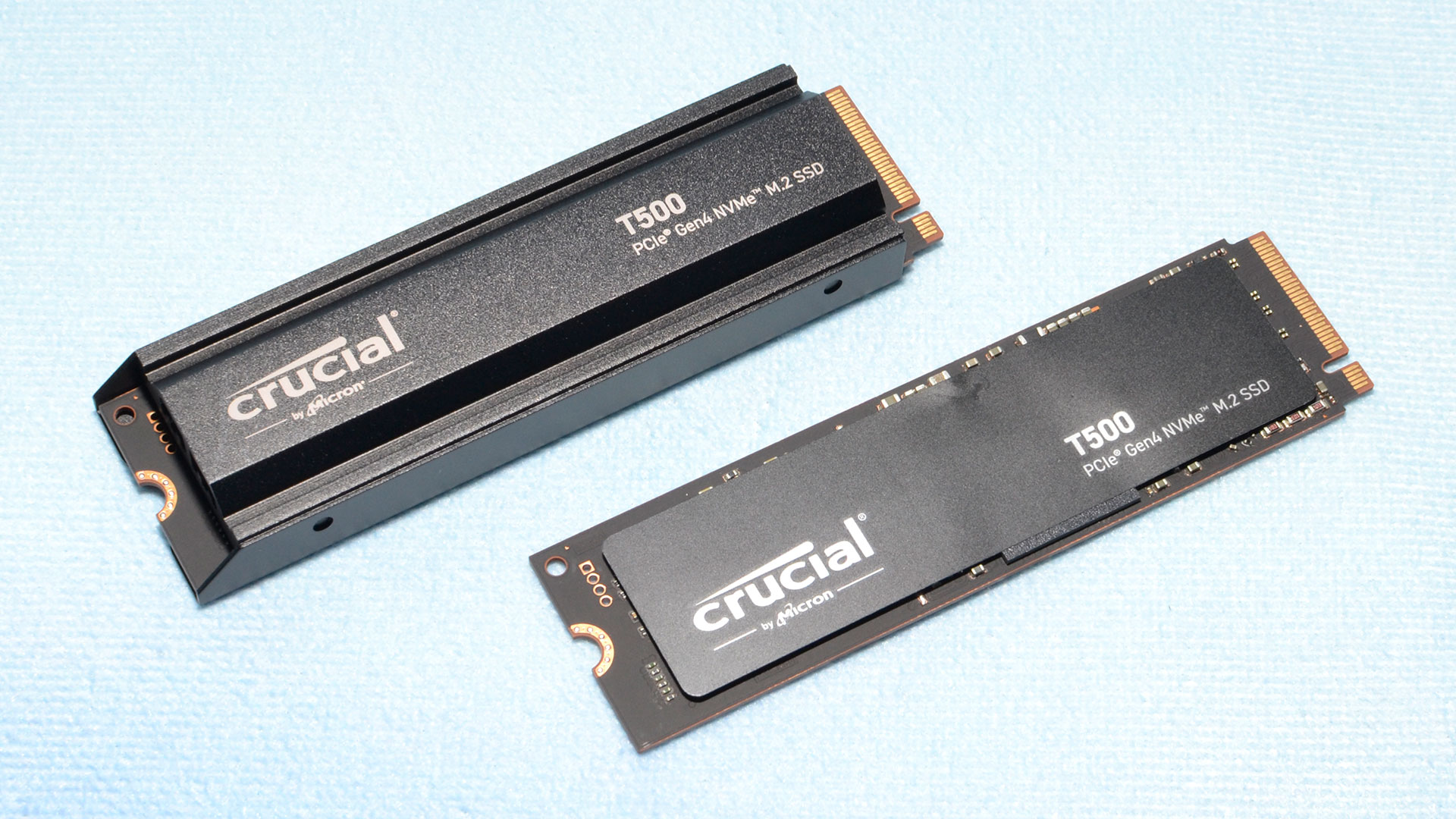Why you can trust Tom's Hardware
Comparison Products
The Crucial T500 has a lot of competition for your eyes as it fits into a space with SSDs bought for desktops, workstations, laptops, and the PS5. Follow its results against specific drives to see what’s right for you, keeping in mind that some adjustments for pricing will be necessary.
The T500 is bound to take comparisons to drives built on the E18 and comparable non-Phison technology, which includes the Seagate FireCuda 530, the Acer Predator GM7000, and the Adata Legend 960 Max. Then there’s the looming threat from Maxio and YMTC with the MAP1602 and Micron-comparable 232-Layer TLC flash, exhibited at 2TB with the Teamgroup MP44.
For laptops and Gen 3 devices, it’s worth sacrificing some peak performance for a single-sided efficient drive, or for more capacity. Popular choices include the TLC-based WD Blue SN580, the QLC-based Solidigm P41 Plus, and the QLC Corsair MP600 Core XT. If budget is the primary concern, Crucial’s P5 Plus has been popular lately. As mentioned previously, Crucial has brought out a heatsink for 1TB and 2TB, but we feel the T500 mostly supersedes it. The P5 Plus may remain a value champion, though.
The T500 is an underdog with its four-channel controller, but the fast bus and DRAM help it to compete with some of the best. If it wants to hang, it needs to go up against the fastest Gen 4 drives: the Samsung 990 Pro, the WD Black SN850X, and the Solidigm P44 Pro. Like with the Gold P31 from two years ago, we expect the T500 to punch above its weight, although perhaps not as definitively with so many options on the table.
Trace Testing: 3DMark Storage Benchmark
Built for gamers, 3DMark’s Storage Benchmark focuses on real-world gaming performance. Each round in this benchmark stresses storage based on gaming activities including loading games, saving progress, installing game files, and recording gameplay video streams.
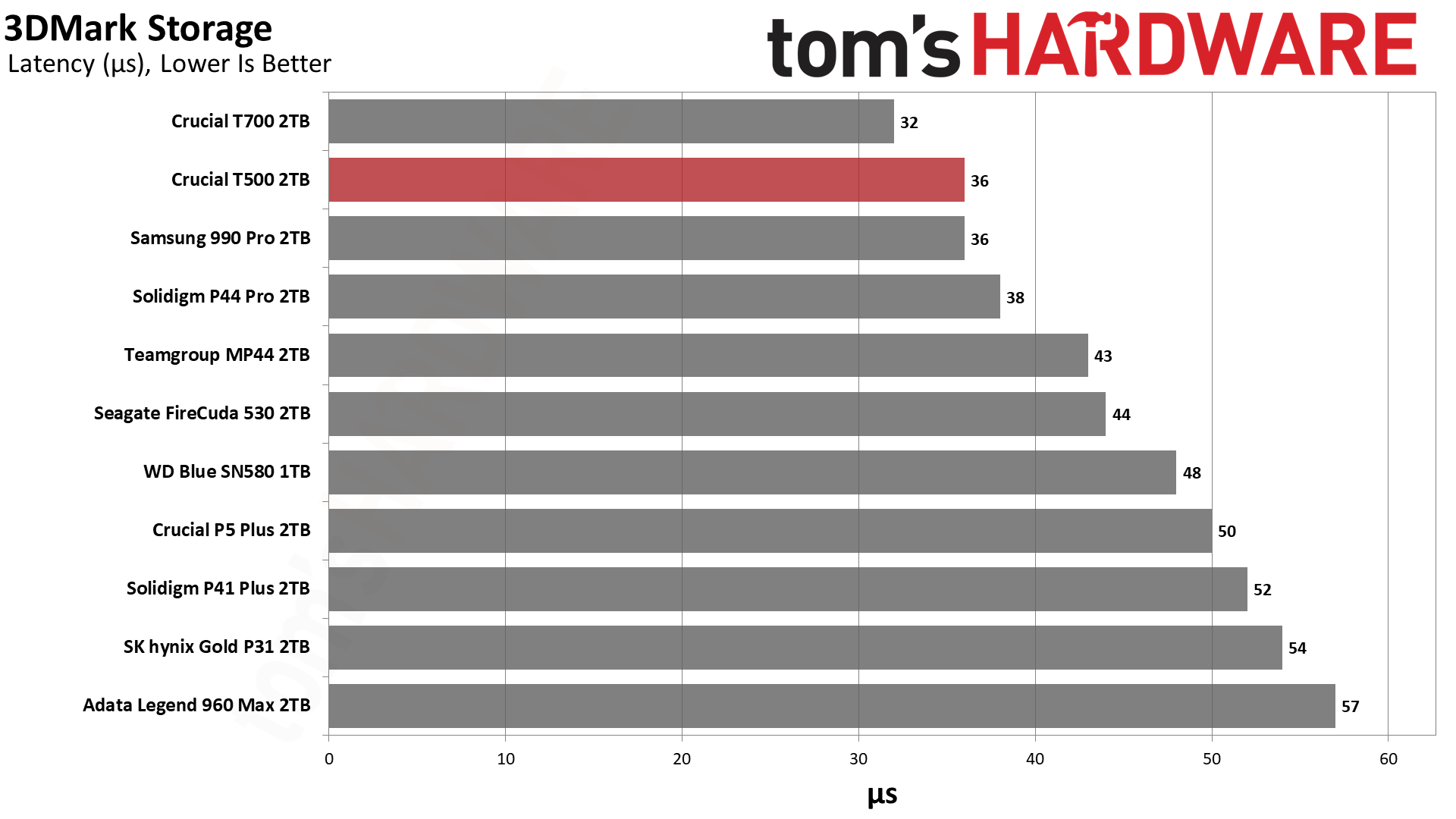
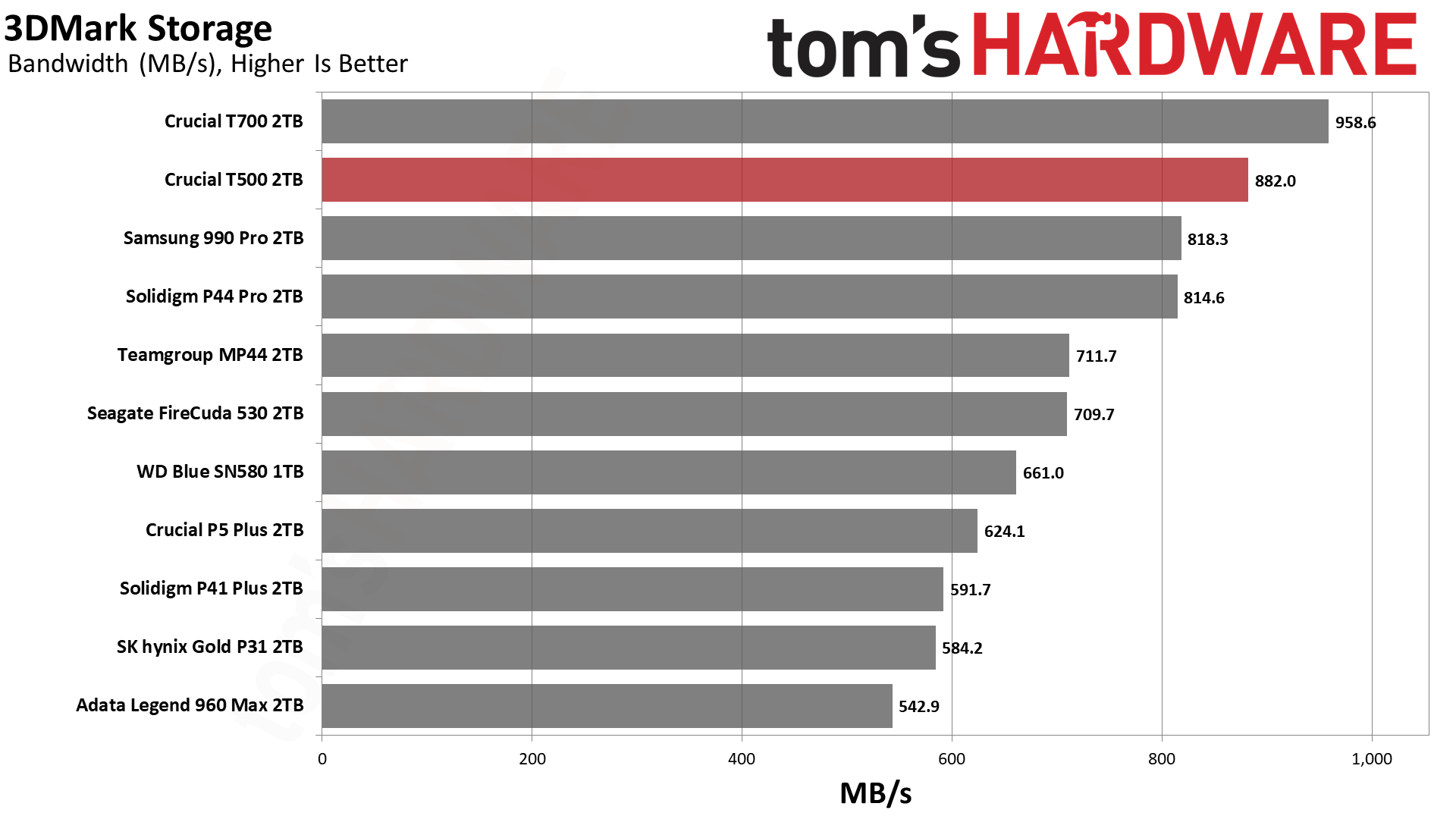
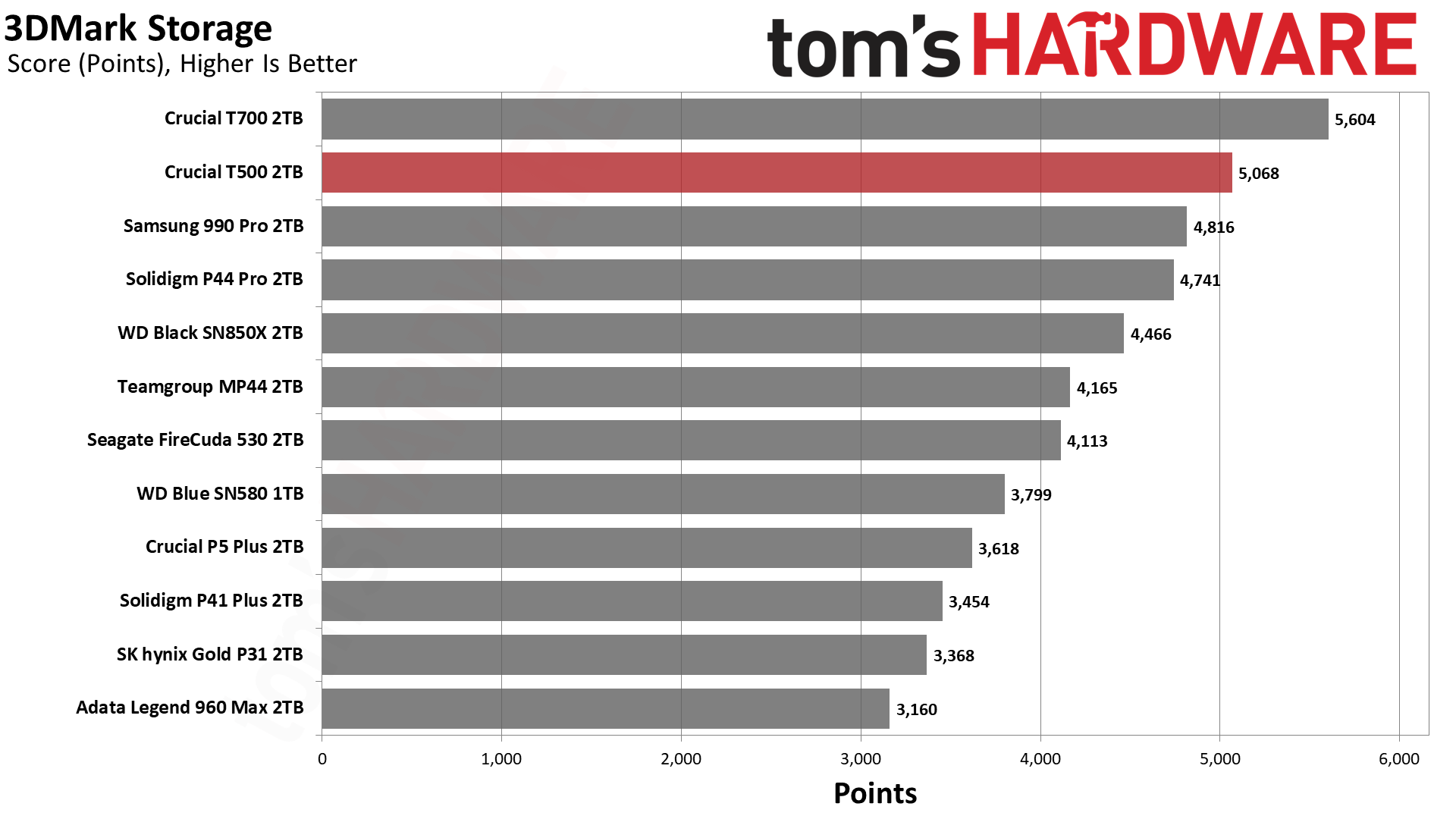
The T500 scores the highest among all Gen 4 drives, coming second only to the Gen 5 T700. As mentioned above, the T500 does have DirectStorage-optimized firmware like the T700, which helps future-proof it a little bit. Micron’s 232-Layer TLC performs quite well here when paired with an agile controller.
Trace Testing: PCMark 10 Storage Benchmark
PCMark 10 is a trace-based benchmark that uses a wide-ranging set of real-world traces from popular applications and everyday tasks to measure the performance of storage devices.
Get Tom's Hardware's best news and in-depth reviews, straight to your inbox.
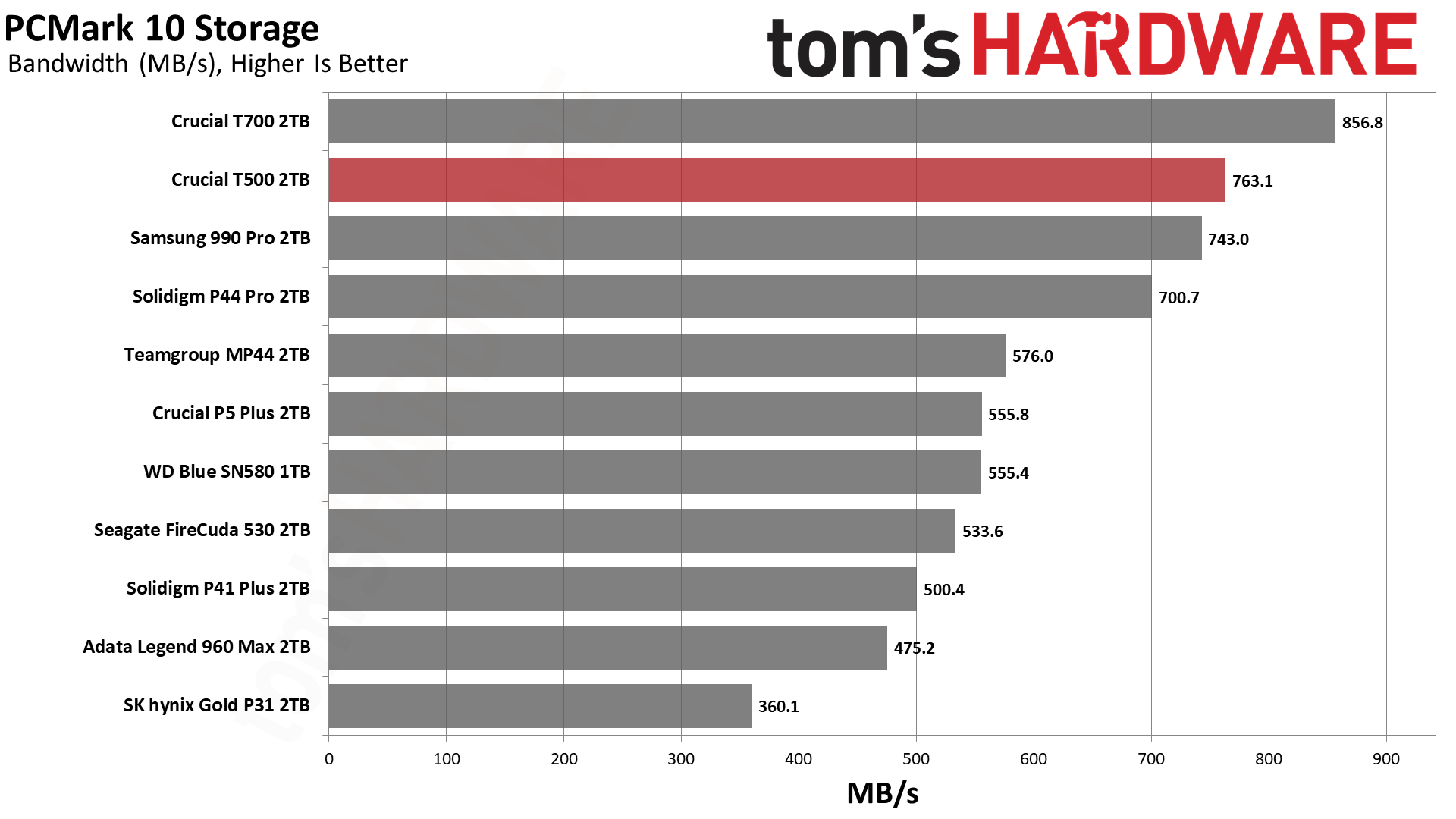
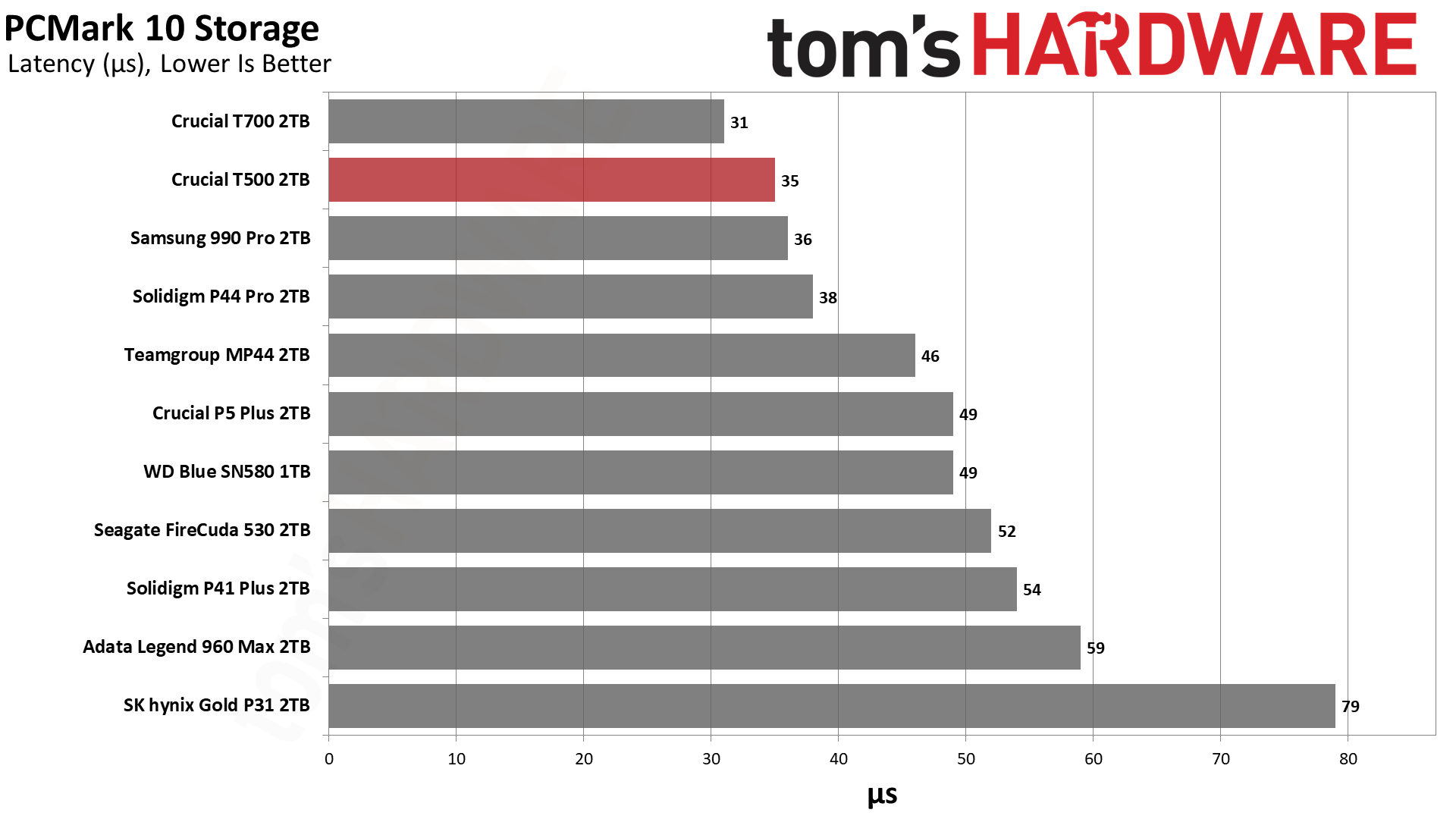

The T500 repeats its success in PCMark 10, topping all Gen 4 drives.
As suggested above, this drive has the hallmarks of being a 990 Pro “killer” in the sense that it’s slotted into the same general performance tier. The hardware is of a comparable generation, and the T500 has DRAM with a hybrid pSLC cache, not to mention Phison’s firmware optimizations. Its four-channel controller design gives it the agility to perform extremely well in everyday applications, as amply demonstrated here.
It also has the advantage of a 500GB SKU and newer flash over the 990 Pro at lower capacities, which makes it compelling for use as a primary performance SSD — that is, for the OS and applications — with the caveat that it currently has no 4TB to match. The T500’s raw horsepower cannot reach the very best, as we’ll see in CDM below, but it’s close enough that this testing feels like comparing the Gold P31 to the 970 EVO Plus in years past.
Console Testing: PlayStation 5 Transfers
The PlayStation 5 is capable of taking one additional PCIe 4.0 or faster SSD for extra game storage, with some requirements. Launch models could not take 8TB drives but this limit has since been removed. While any 4.0 drive will work, Sony specifies drives that can deliver at least 5,500 MB/s of sequential read bandwidth are optimal. The PS5 does not support the host memory buffer (HMB) feature but DRAM-less drives will still work. In our testing, PCIe 5.0 SSDs performed irregularly and should not be used in the PS5, especially as they may require additional cooling. Please see our Best PS5 SSDs article for more information.
Our testing utilizes the PS5’s internal storage test and manual read/write tests with over 192GB of data both from and to the internal storage. Throttling is prevented where possible.

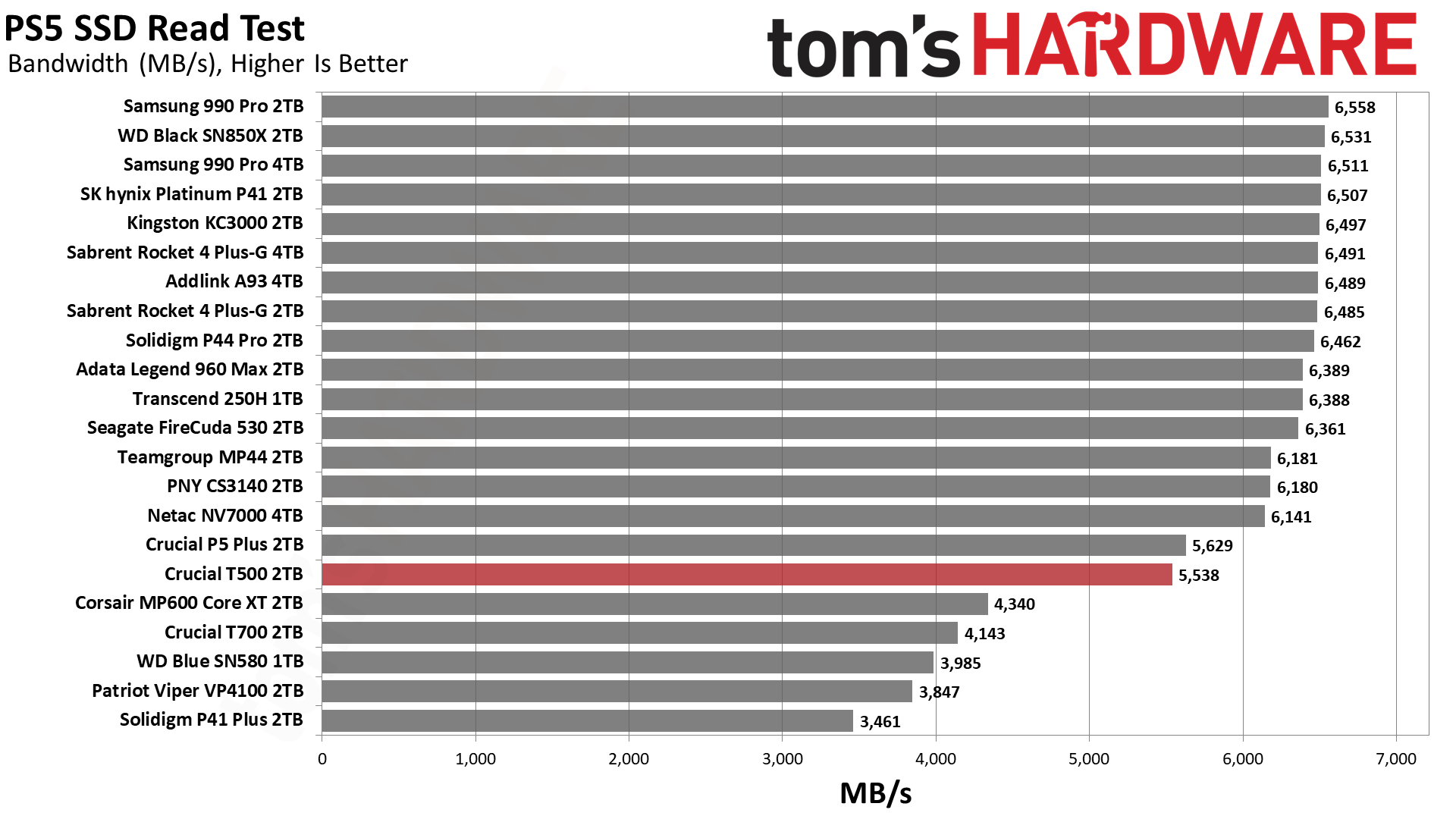
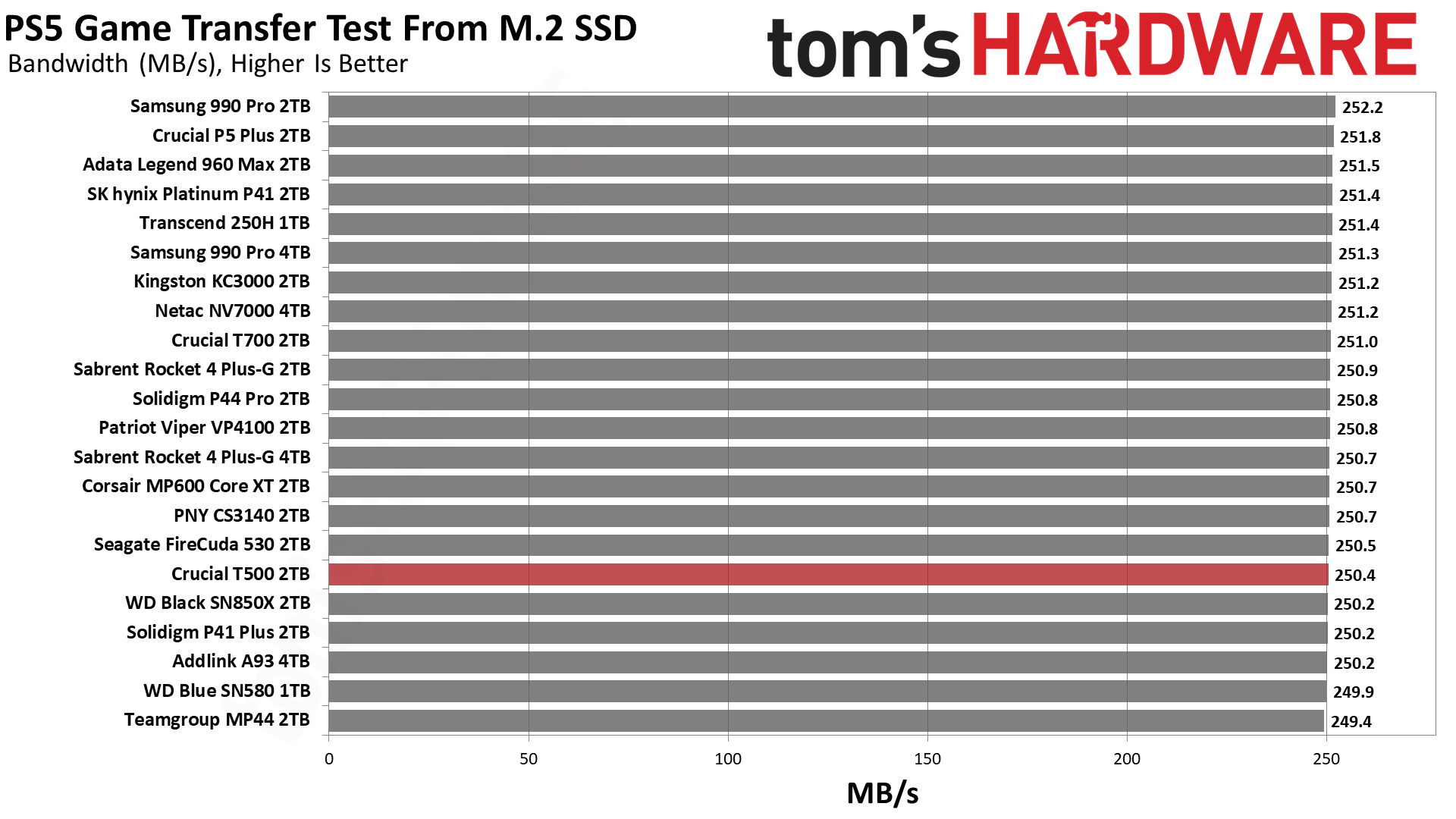
We see very little variance between drives when writing from M.2 to the internal storage. The internal storage bottlenecks performance at around 250 MB/s due to encryption and anti-tampering checks. When transferring from the internal storage to the secondary SSD, the destination drive’s pSLC cache can be important for performance with larger transfers. The Transcend 250H and its small cache come up short here, as an example.
The PS5 read test is more variable and less reliable. It doesn’t track properly with Gen 5 drives and is susceptible to thermal throttling. Multiple runs can correct for any variability. The T500 and P5 Plus both performed worse than expected here but still above the mark recommended for the PS5. In practice, these drives all performed similarly with games.
As long as your drive is running cool enough, it’s safe to go with whatever has the lowest price per GB for your PS5 storage. A compatible heatsink is a nice addition, though, and worthwhile in our minds. Reliability is a concern but more difficult to gauge, although it is wise to get a drive from a brand you trust for support in the case of an RMA.
Transfer Rates: DiskBench
We use the DiskBench storage benchmarking tool to test file transfer performance with a custom, 50GB dataset. We copy 31,227 files of various types, including pictures, PDFs, and videos, to a new folder and then follow-up with a reading test of a newly-written 6.5GB zip file. The PC is rebooted between tests so that OS caching of data doesn't factor into the results.

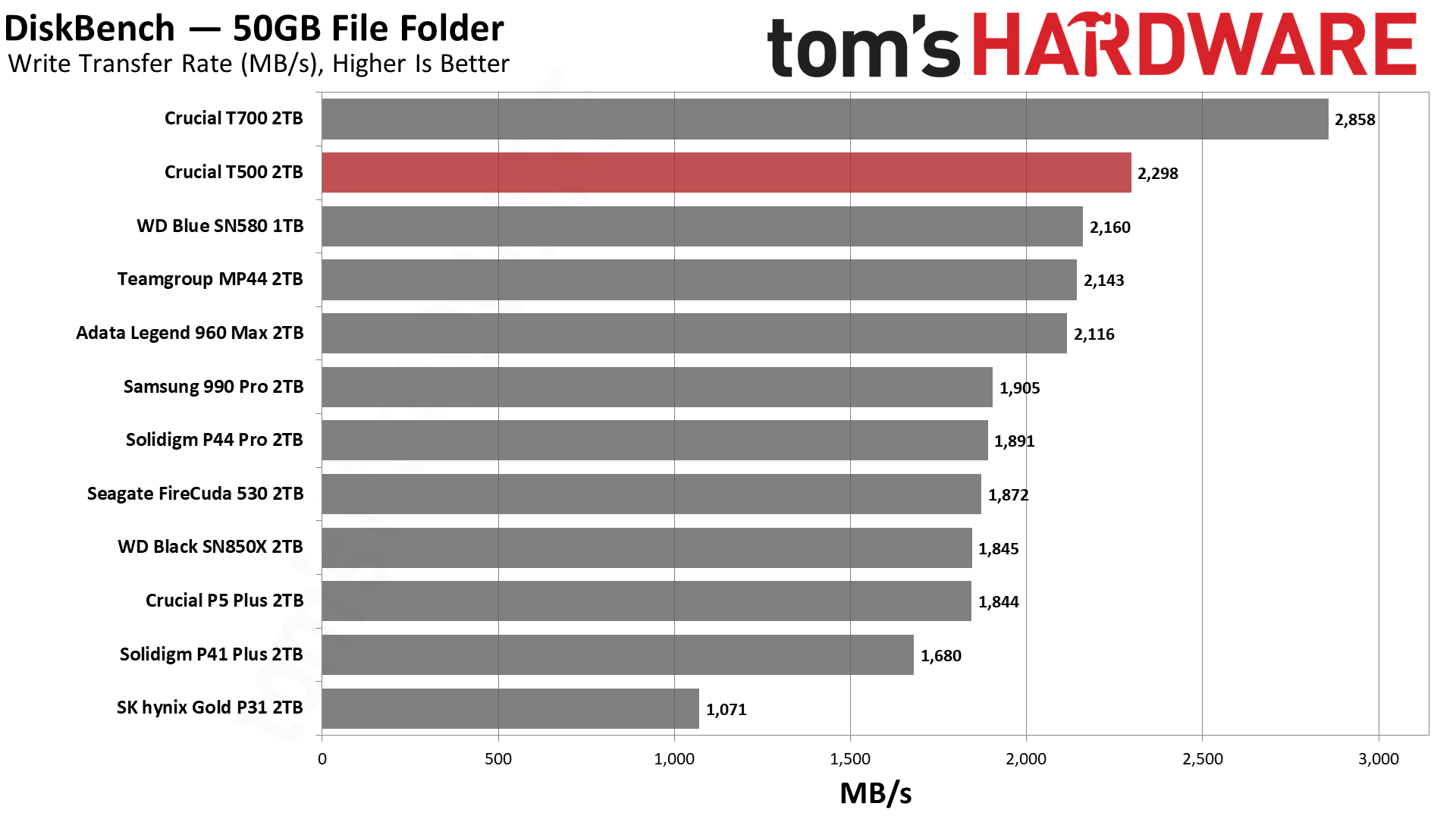
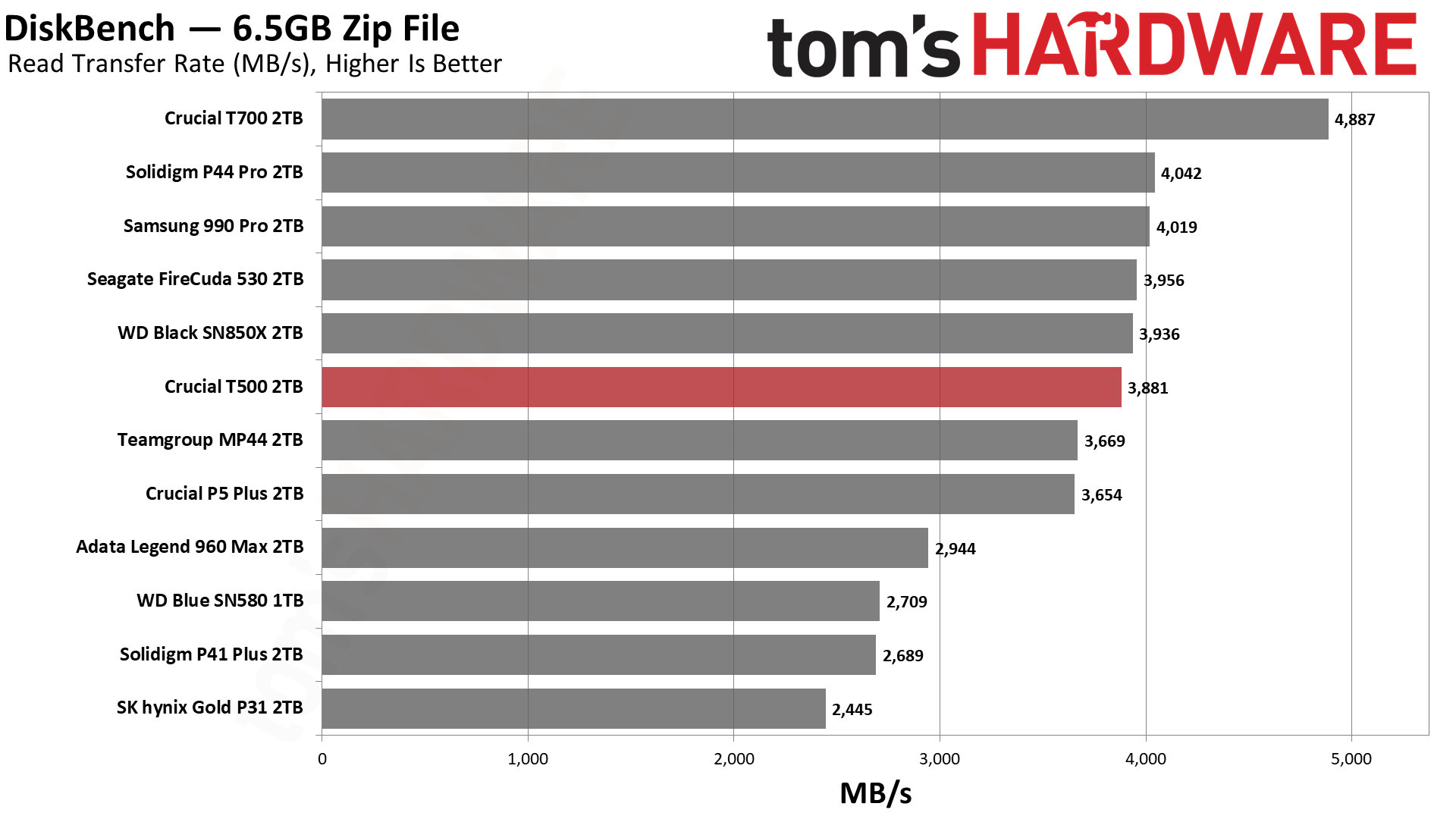
The T500’s high bus speed and the ample amount of dies on the 2TB model help this drive copy at a record rate for a Gen 4 SSD. The pSLC cache is fast, but it has characteristics that could hold the drive back in some scenarios, further investigated under our write saturation testing below.
One great purpose of DiskBench is to illustrate copy consistency as it engages both reads and writes with a realistic file/folder transfer rather than imposing artificial sustained writes. In the former, the T500 performs excellently. Sustained writes, not so much.
Synthetic Testing: ATTO / CrystalDiskMark
ATTO and CrystalDiskMark (CDM) are free and easy-to-use storage benchmarking tools that SSD vendors commonly use to assign performance specifications to their products. Both of these tools give us insight into how each device handles different file sizes.
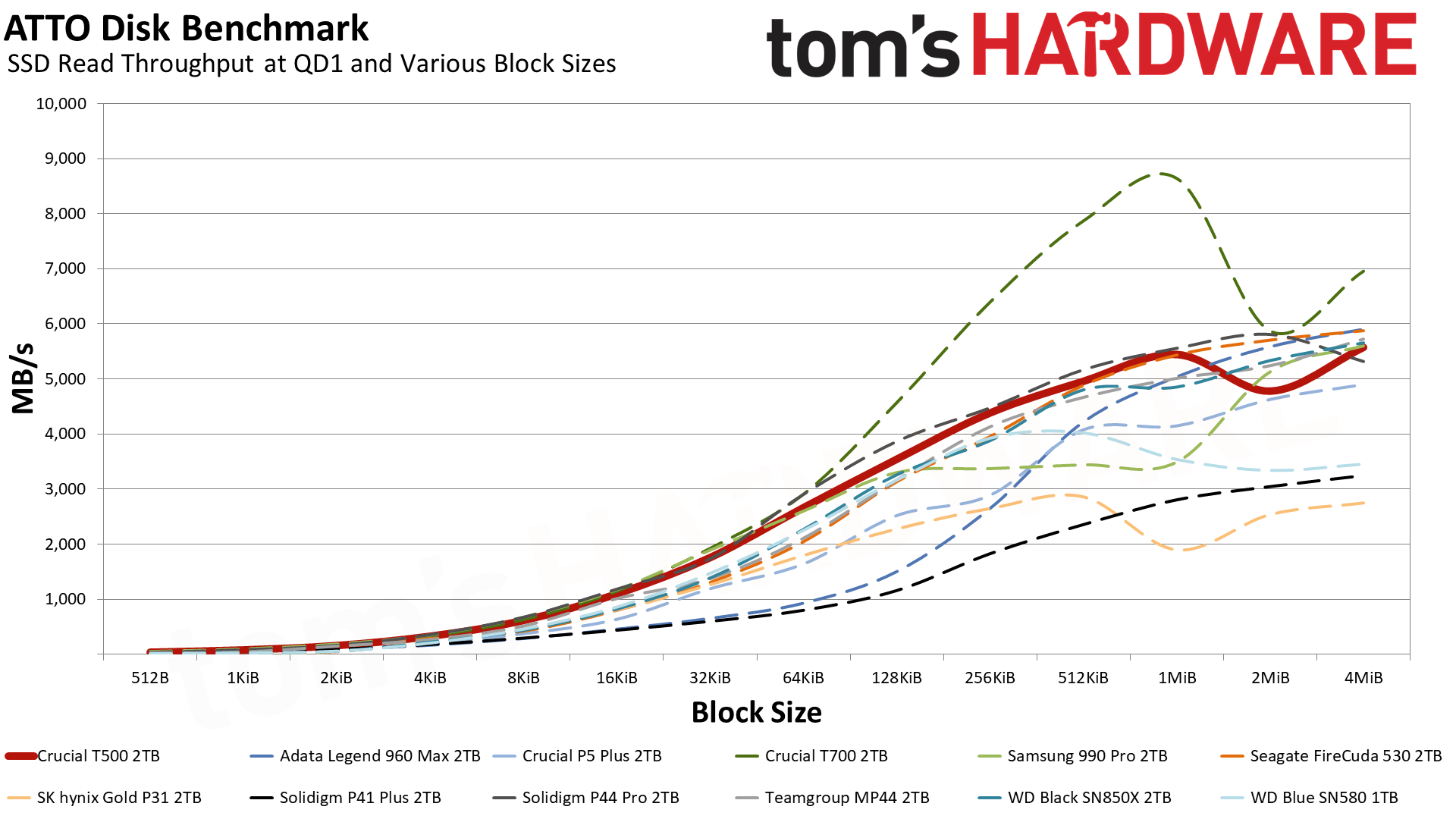
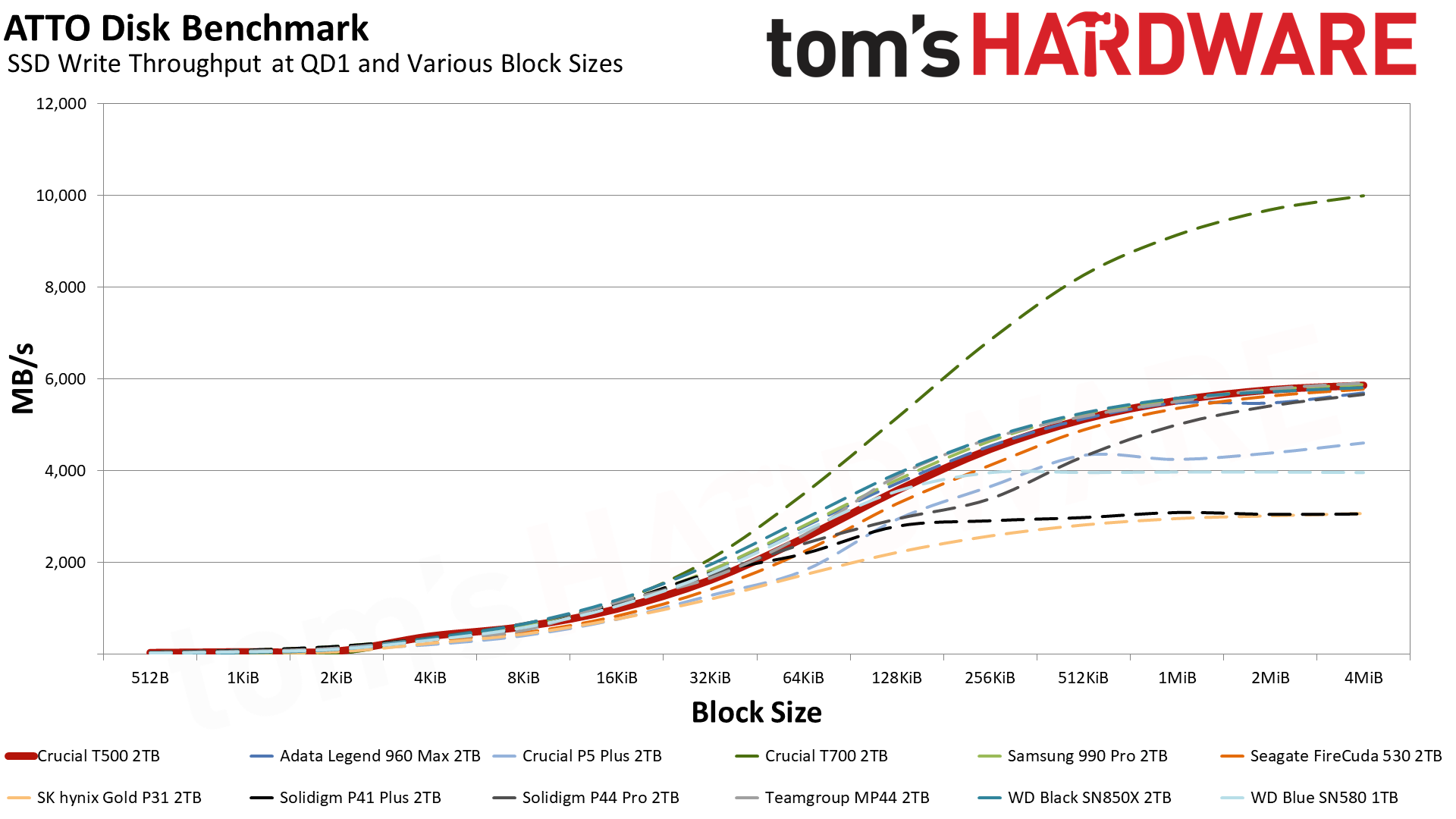
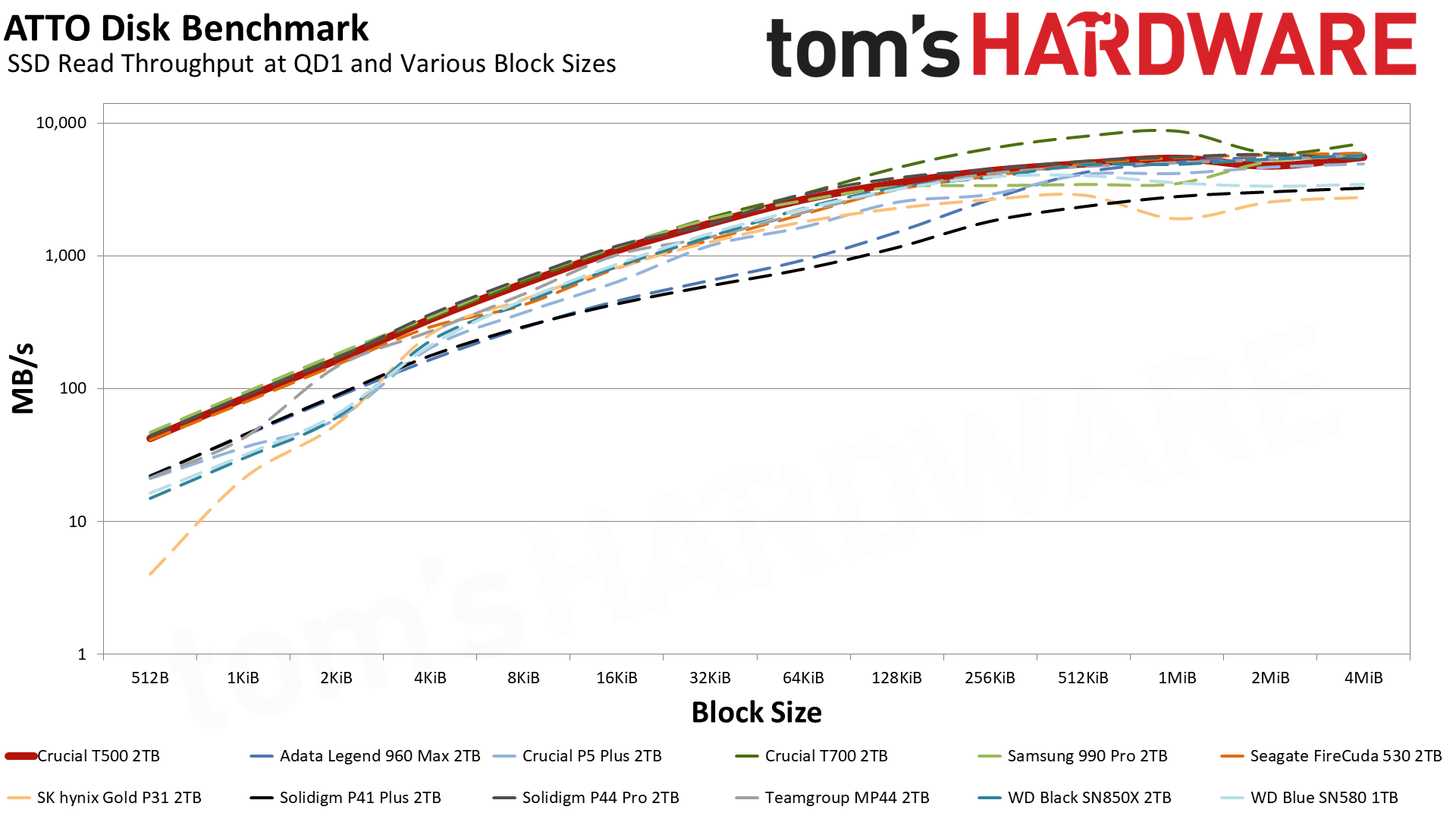


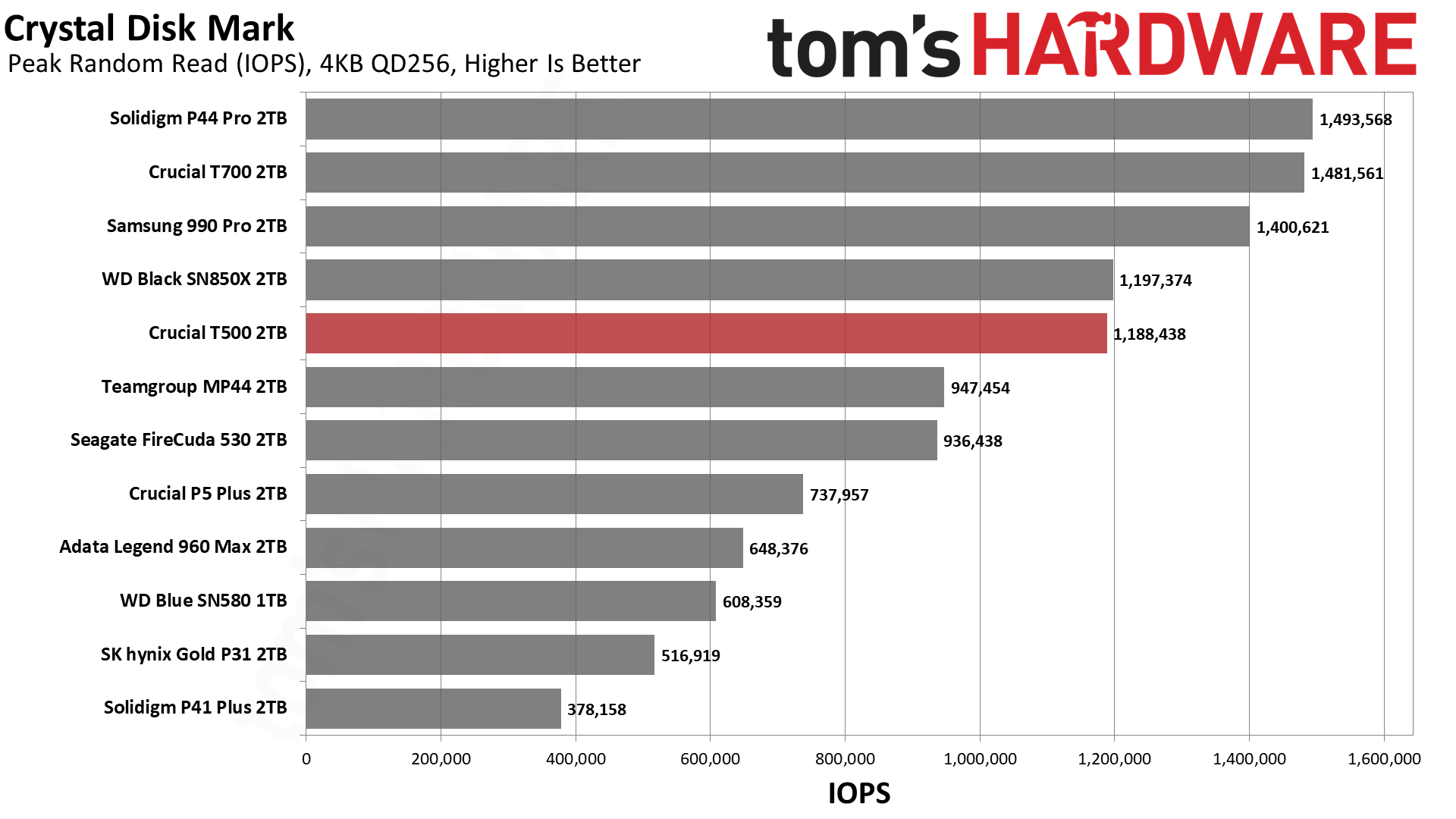

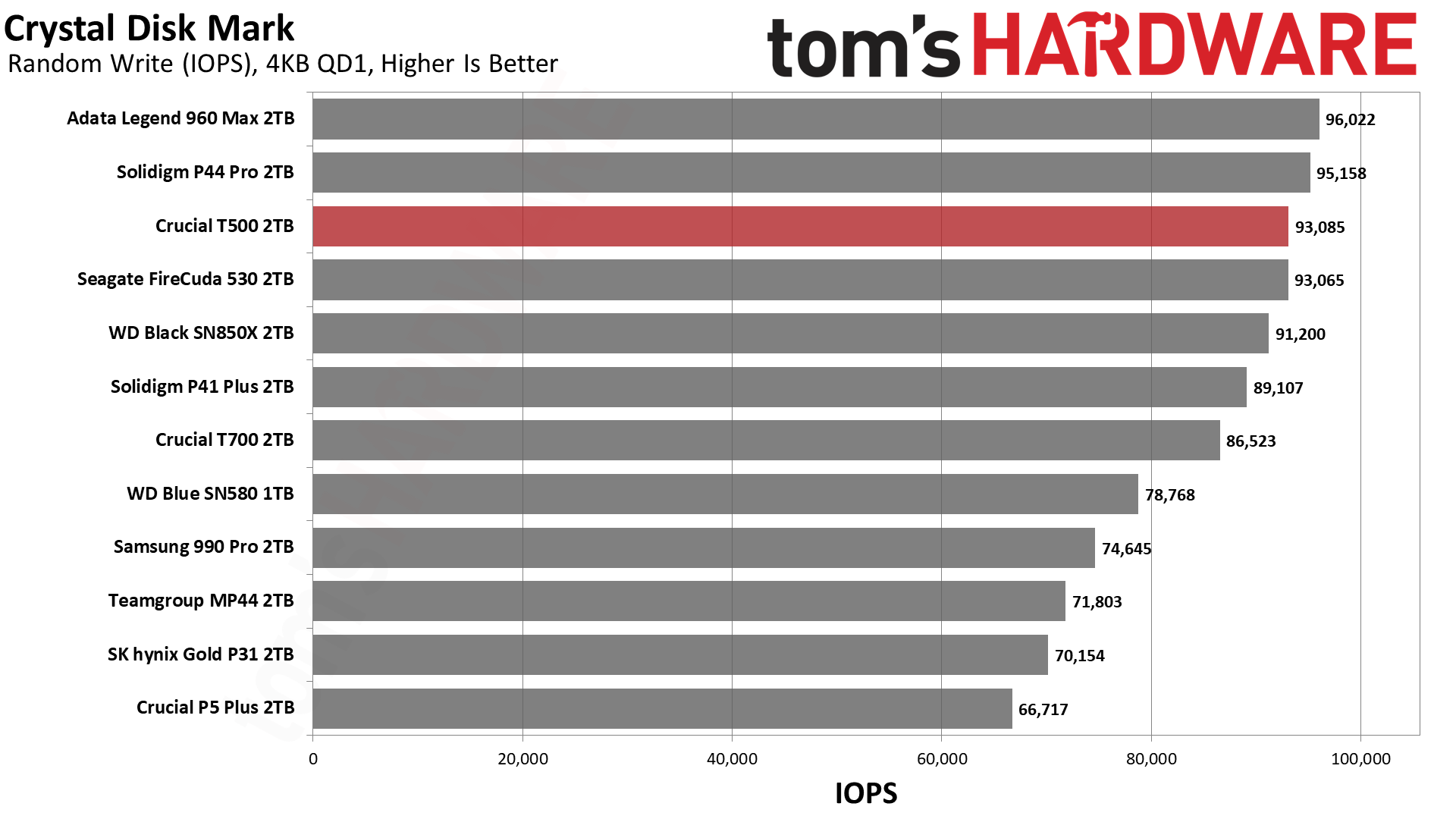

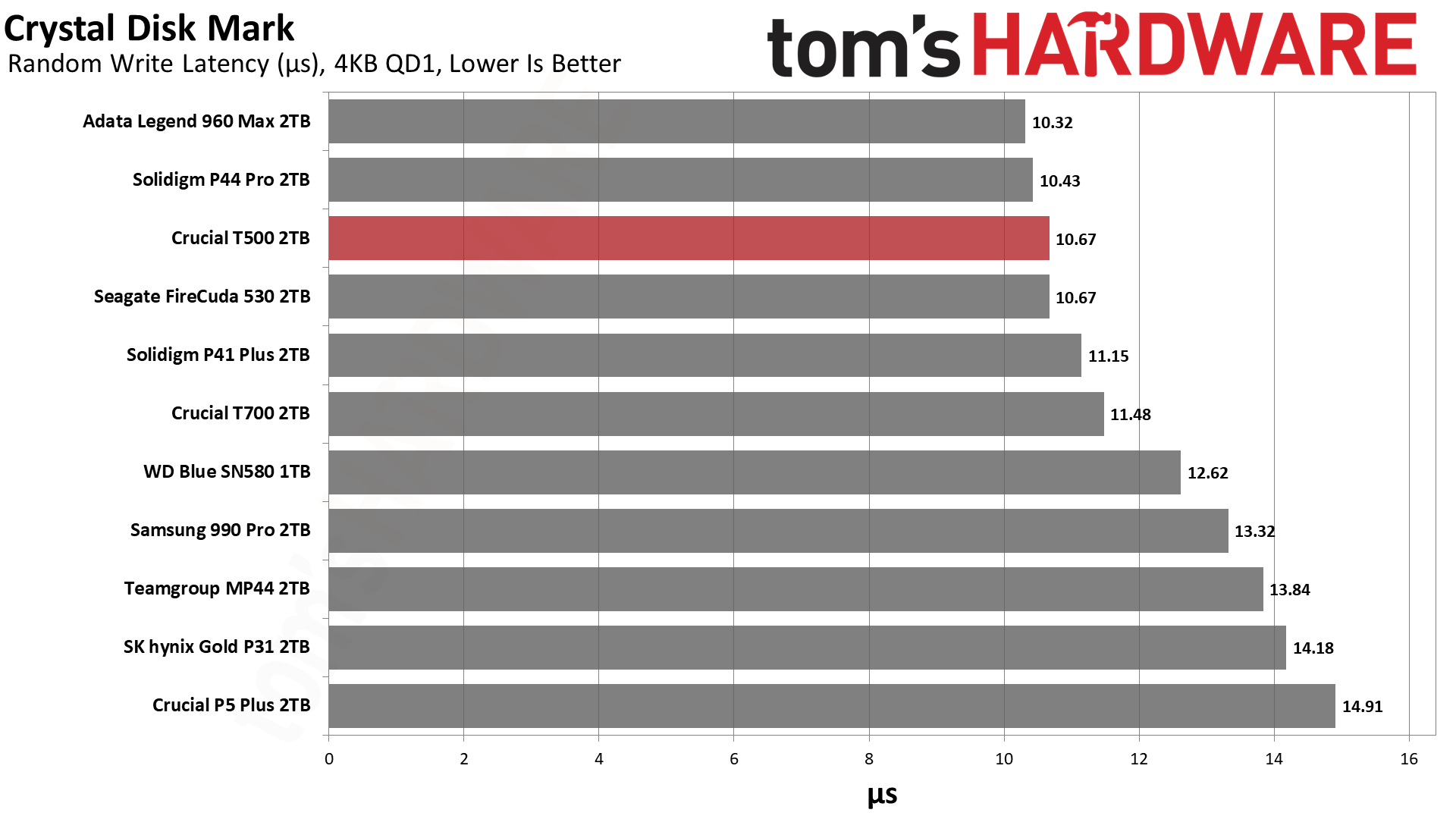
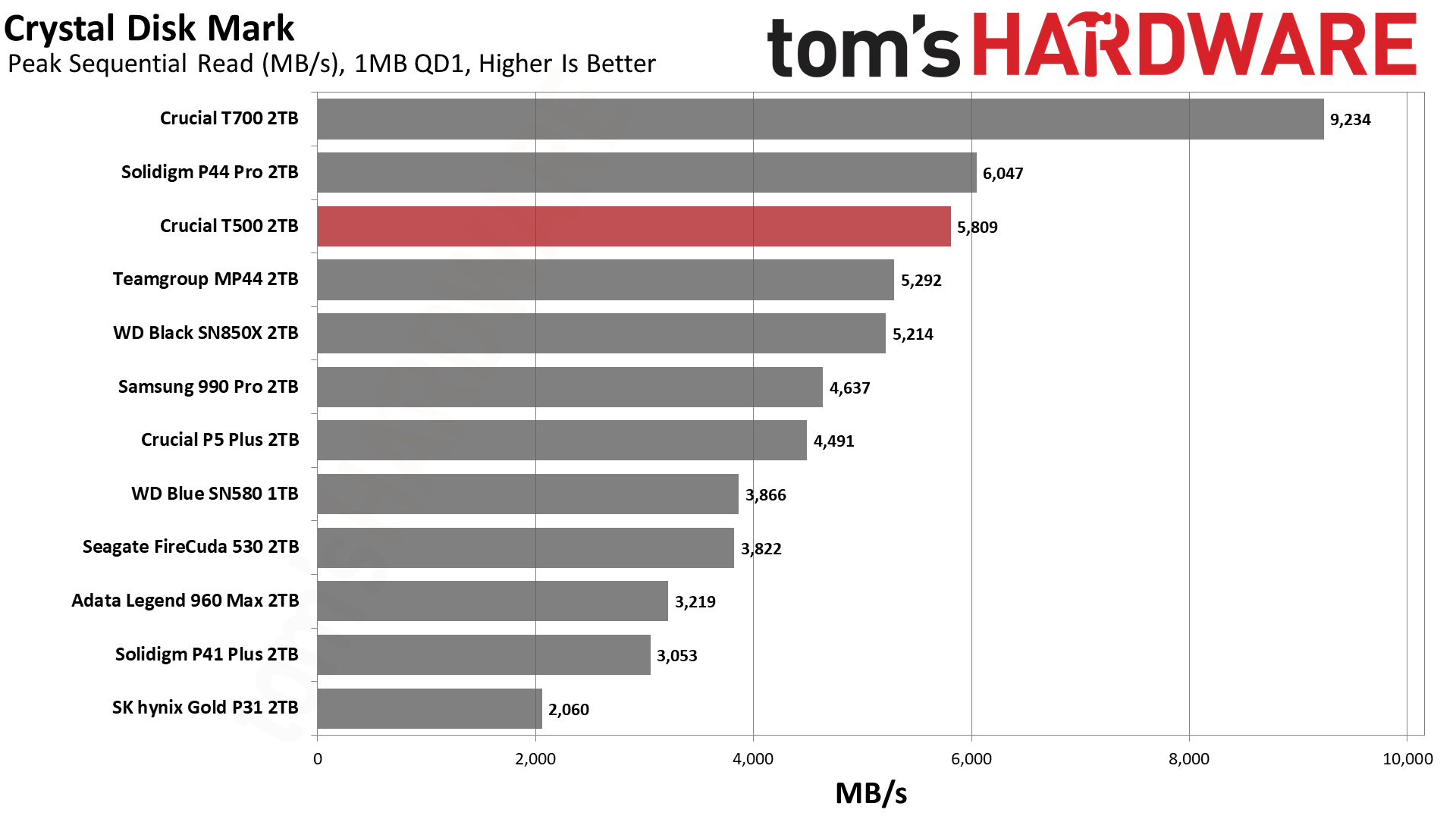
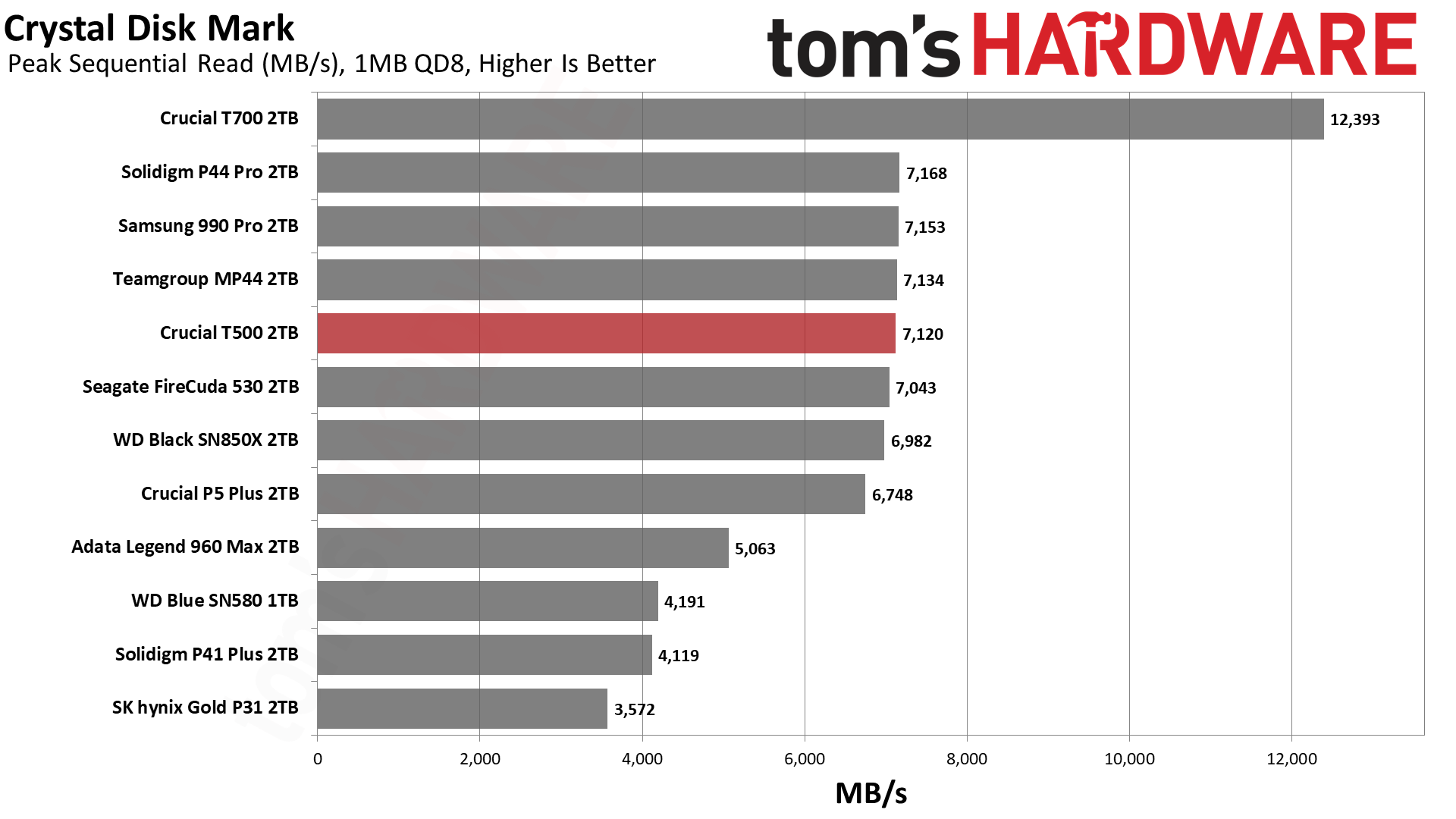
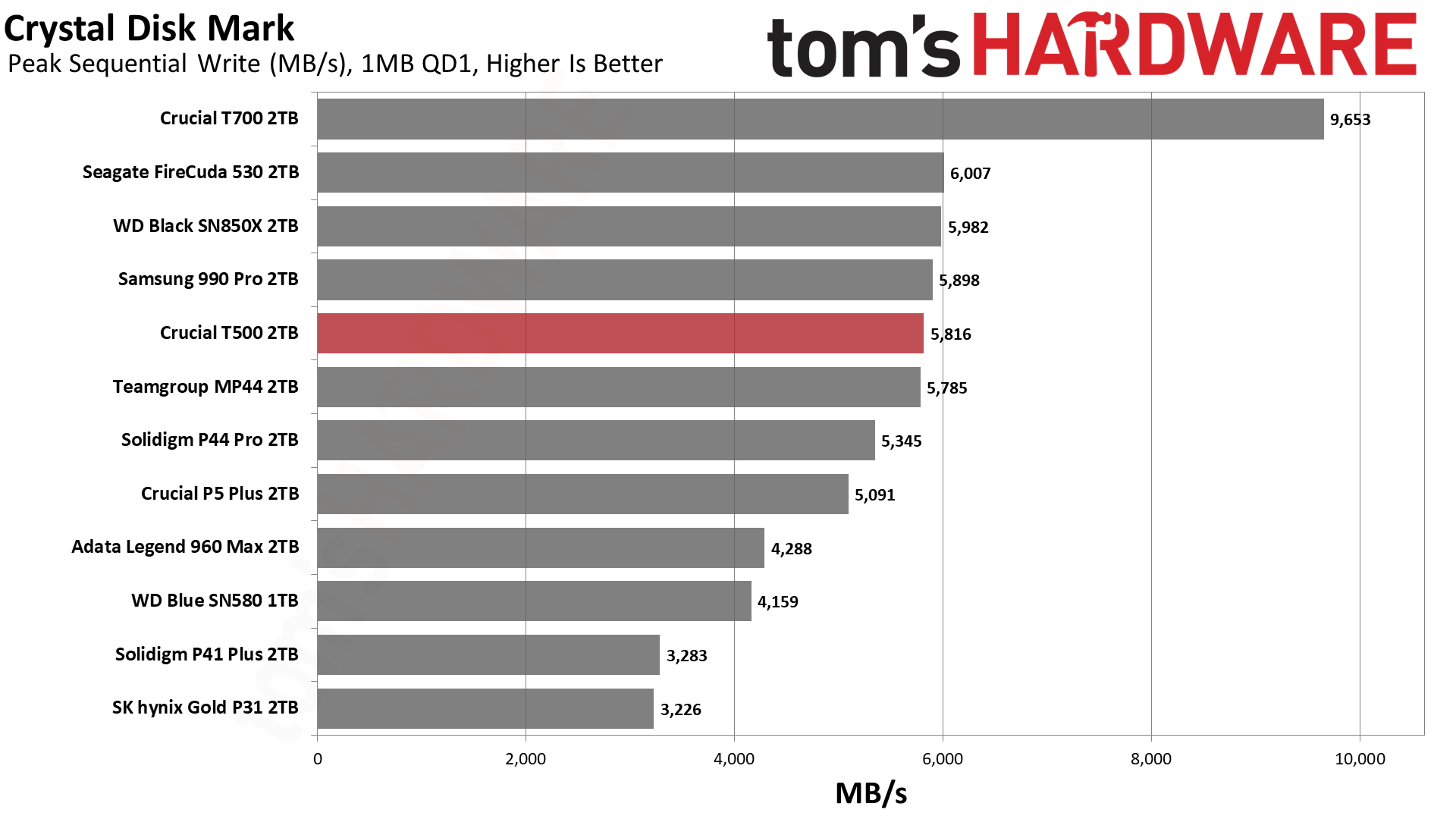
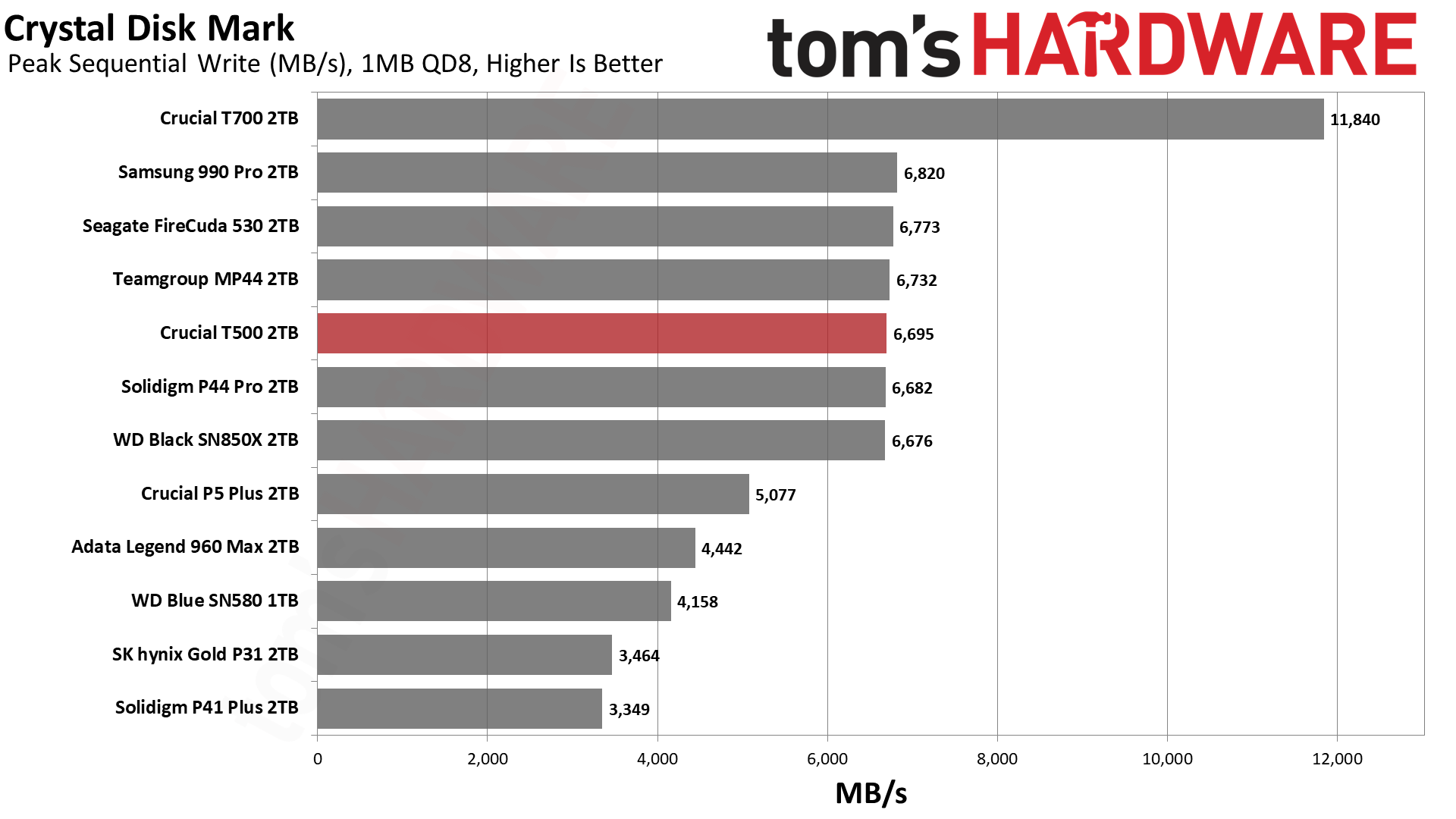
ATTO performance is good but not exemplary. We see a valley at the 2MB point for reads, which appears to be common with this flash on Phison controllers, as exhibited by the T700. This may be a nuance of the controller for that block size, given the configuration of the flash. Taking a logarithmic look at smaller block sizes, we see a dip at 2KB for writes before the anticipated 4KB bump — 4KB being a special number and a good logical page size. The T500 handles this better than the T700. As for CDM sequential results, we see no problems.
Random 4KB performance in CDM is reasonably good. The T500 reaches high levels of IOPS with high queue depth given the controller’s relative horsepower — from our understanding, its main core configuration is in-between the E18 and upcoming DRAM-less E27T, but may be clocked higher than the E18 — which helps position it as a competitor against beefier drives. At the other end, with low QD, write latency is quite good, and read latency is excellent.
This flash can’t quite touch the Samsung’s 990 Pro’s NAND for the latter, but it’s worth recalling that Samsung is using newer flash for its 4TB SKU, which has found or may find its way into the 2TB SKU as well. That 236-Layer flash has higher read latency than the T500 shows here, so this result is excellent. It’s also worth noting that a 4TB SKU is planned for the T500, which will put more pressure on some competing drives.
In either case, we do see some read latency improvement over the T700. One possible source for this is the E25’s improved error correction. It’s using next-gen LDPC error correction, one iteration ahead of the E26 and E27T but one behind the upcoming E31T. This is 4K rather than the 2K LDPC found on the E18, which does suggest superior error correction capability over older drives, too. However, this enhancement can require more compute or die area overhead.
Improved ECC was a factor in the SM2259 and SM2259XT controllers compared to the SM2258 and SM2258XT, first demonstrated on the Intel 545s. In that case, 4KB read performance did seem to improve slightly, which makes sense as improved LDPC can reduce read latency and will improve read latency as well as endurance with wear. The T500’s TBW rating is standard, and while it’s true that flash requires better ECC as effective cell size diminishes, we still think this is a net positive to bring the controller in line with competitors from Maxio, SMI, and InnoGrit. It’s particularly a worthwhile improvement for 232-Layer and higher flash and optional QLC.
Sustained Write Performance and Cache Recovery
Official write specifications are only part of the performance picture. Most SSDs implement a write cache, which is a fast area of (usually) pseudo-SLC programmed flash that absorbs incoming data. Sustained write speeds can suffer tremendously once the workload spills outside of the cache and into the "native" TLC or QLC flash.
We use Iometer to hammer the SSD with sequential writes for 15 minutes or more to measure both the size of the write cache and performance after the cache is saturated. We also monitor cache recovery via multiple idle rounds.
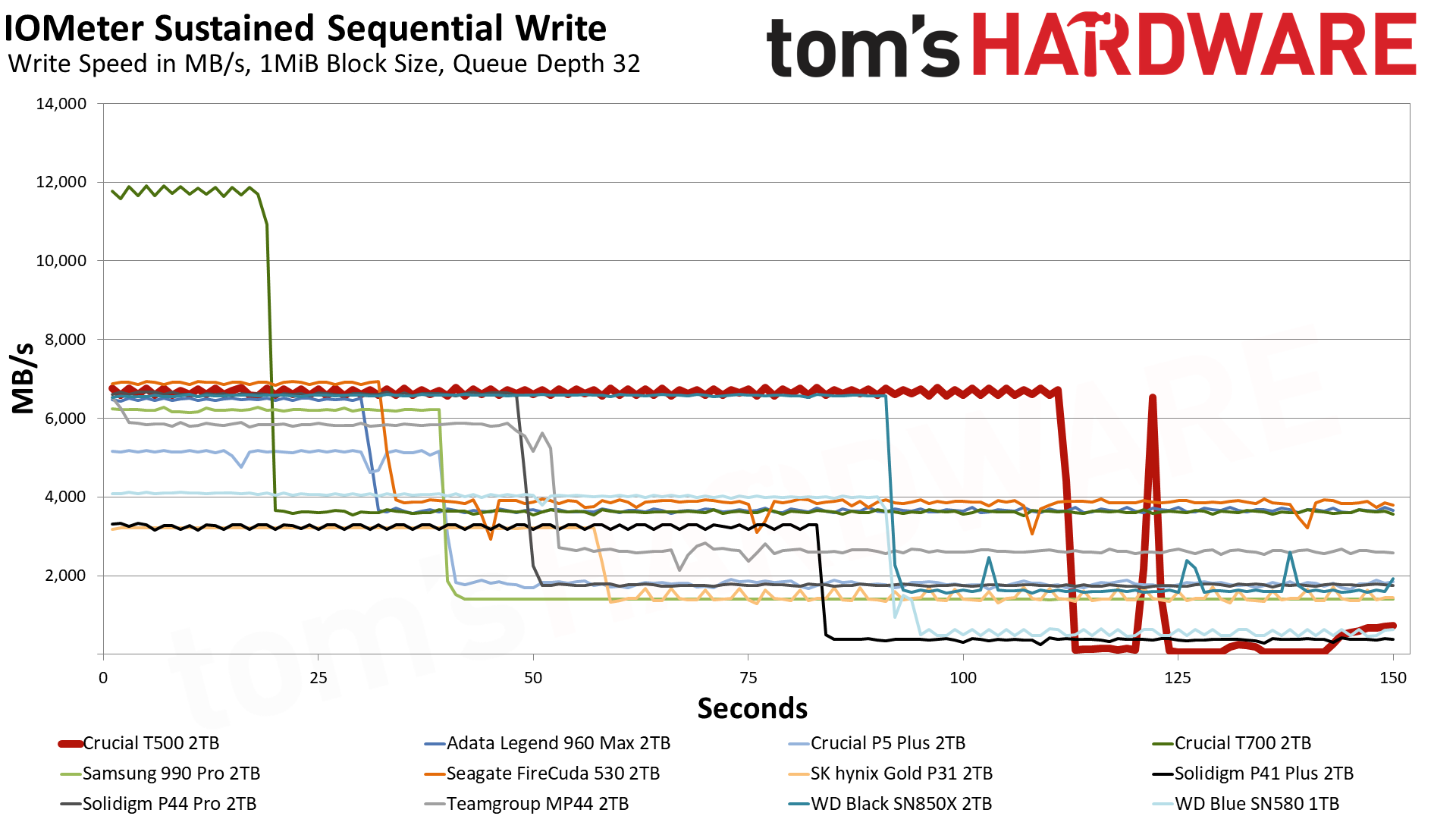
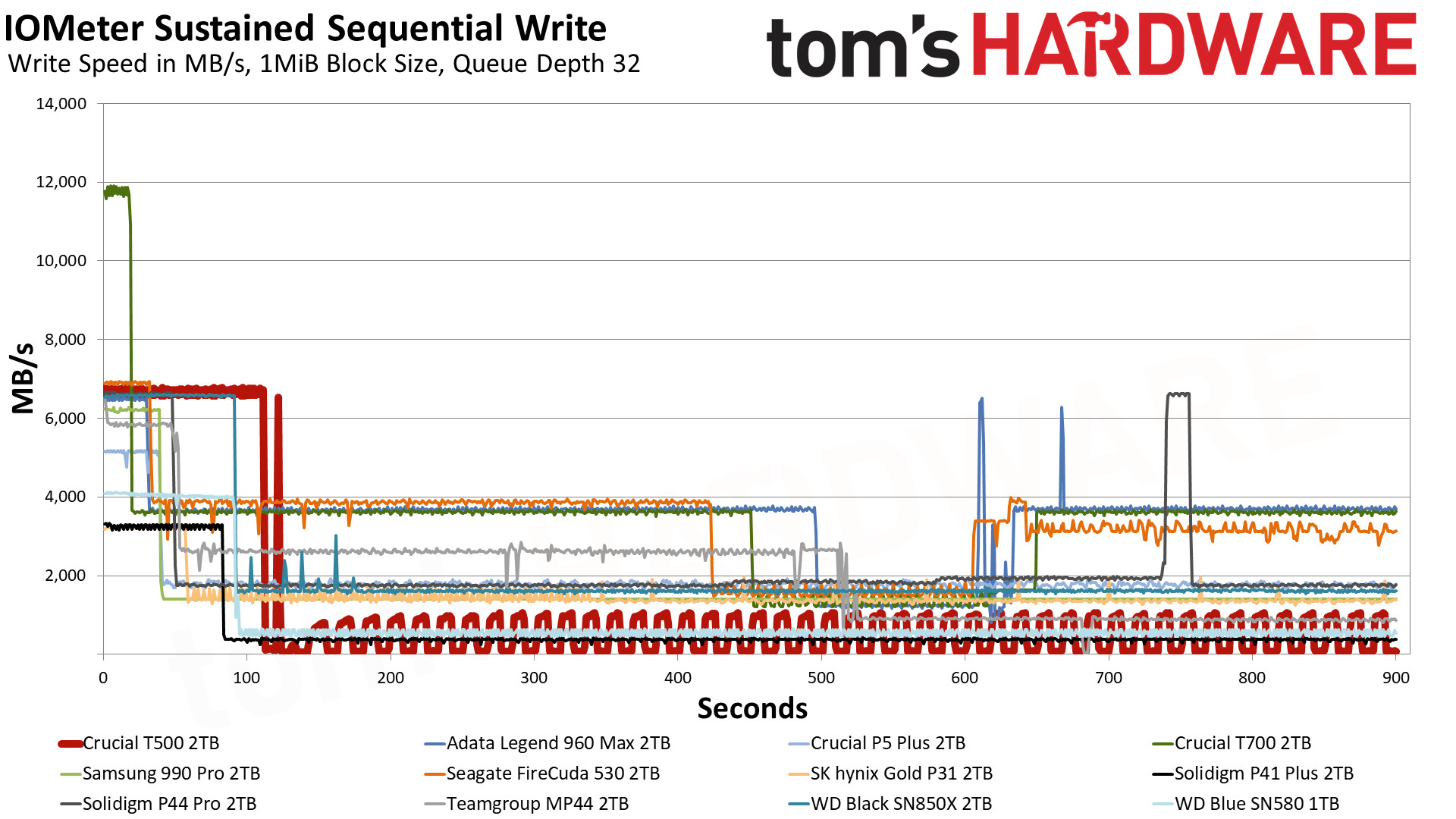
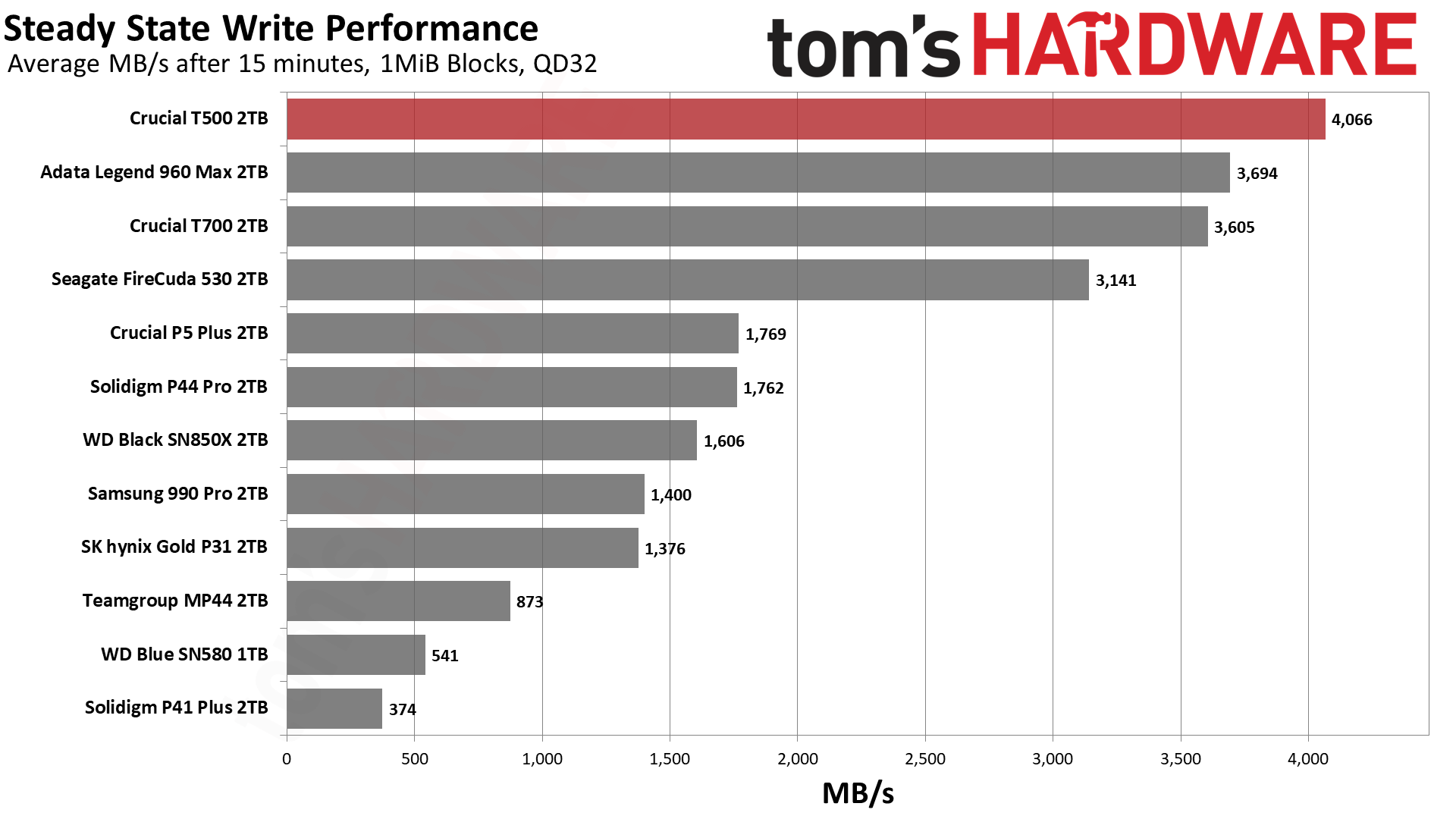
Write saturation is the first place we begin to see oddities with the T500. It writes just fine to the pSLC cache, but the overall behavior after that point is a bit unexpected. The cache is larger than anticipated, and as a result, the folding mode on this drive is slow and very inconsistent. We double-checked our results before communicating with Crucial about intended versus demonstrated behavior.
Crucial has designed the T500 to have a cache equal to about 20% of the user capacity, which varies from 12 to 28 percent depending on the capacity of the SKU. This means that over 80% of the TLC might be set to pSLC mode in some cases. We expected a more conservative cache design for this drive with better TLC steady state performance, as we know this flash can do much better. However, we find the inconsistency in the folding mode to be more concerning than the average transfer rate, even if the intention was to have an SN770- or SN580-like aggressive cache.
The folding state ends up taking quite a lot longer than we're used to seeing. After good initial throughput, the T500 dropped to just ~460 MB/s on average, oscillating between ~150 MB/s and ~850 MB/s. That continued for about 40 minutes, after which the T500 recovers to a more impressive ~4 GB/s. It doesn't maintain that speed forever, as we saw short boosts back to 6.6 GB/s for about 20 seconds, then a big drop to ~150 MB/s for ten seconds, followed by about 45 seconds of ~860 MB/s. Finally, it would then return to a relatively steady ~4 GB/s for another 2.5 minutes.
But even then, it wasn't quite done. After another 460 seconds of 4.1 GB/s, we again got a 20 second burst at 6.6 GB/s, followed by 55 seconds of slow then not-quite-as-slow performance (740 MB/s), and then back to 4 GB/s again. That continued until the end of our one hour test sequence. So, the pSLC cache and recovery aren't quite what we normally see, but if you need to write a lot of data to the SSD at once — like, if you just want to completely fill it up — you should see some slowdowns after the first ~750GB, and with the remaining 1.3TB of data writing at a far more sedate ~500 MB/s.
Based on information from Crucial, this effect should be less pronounced on the 2TB model. However, we found that not to be the case. If Crucial can bring this cache in line with its intentions, we would expect much better results. Crucial is aware of this and is working to put out a firmware update, which should be available in the Storage Executive tool at a later time. We fully believe this is fixable as the hardware technology is known and proven.
Our recommendation would be to optimize the cache size and tone down cache recovery, even if that has some general performance trade-offs. The T500 is more than fast enough for its spot and gets a lot out of its controller. Even a steady 500 MB/s post-cache would be fine, although we know higher is possible. This drive will not replace others for serious sustained writes, and that’s not a target workload for the T500. However, with its controller horsepower and the presence of DRAM, it should be able to compete reasonably here and perform well in a fuller-drive state.
Remember that this is an edge case, and the drive performs very well otherwise, generally meeting Crucial’s expectations for the intended audience. Not many review sites thoroughly test sustained write performance, which, as a result, lets issues like this fall between the cracks. One might be reminded of an issue with certain Phison M.2 2230 drives involving data loss, also discovered through sustained write testing. So, while we don’t think this will impact most users, we do think it’s worthwhile to complete and show the testing to encourage firmware rollouts.
An updated T500 may not perform exactly along these lines, but it gives a feel for peak performance, around 6.4 GB/s in pSLC mode. When we suggest relaxed recovery above, it’s because this drive is over-eager to recover pSLC while idle, which, with an adjusted pSLC cache size, could relax to a higher TLC level of performance. This sounds technical, but it’s more of a design philosophy because the four-channel, DRAM-less drives the T500 is up against lean towards aggressive caching while many eight-channel, DRAM-equipped Gen 4 SSDs are more balanced.
The Gold P31 is designed more like the latter, and we prefer that level of consistency but can understand Crucial focusing more on the former. These results certainly suggest the T500 was intended to compete with the former, but we think Crucial can adjust this to be more moderate without a significant trade-off. The post-pSLC performance is really our only complaint about the drive. We hope Crucial addresses it carefully, as the run-out issue will be more pronounced with the 500GB SKU.
Power Consumption and Temperature
We use the Quarch HD Programmable Power Module to gain a deeper understanding of power characteristics. Idle power consumption is an important aspect to consider, especially if you're looking for a laptop upgrade as even the best ultrabooks can have mediocre storage.
Some SSDs can consume watts of power at idle while better-suited ones sip just milliwatts. Average workload power consumption and max consumption are two other aspects of power consumption, but performance-per-watt is more important. A drive might consume more power during any given workload, but accomplishing a task faster allows the drive to drop into an idle state more quickly, ultimately saving energy.
For temperature recording we currently poll the drive’s primary composite sensor during testing with a 24C ambient.
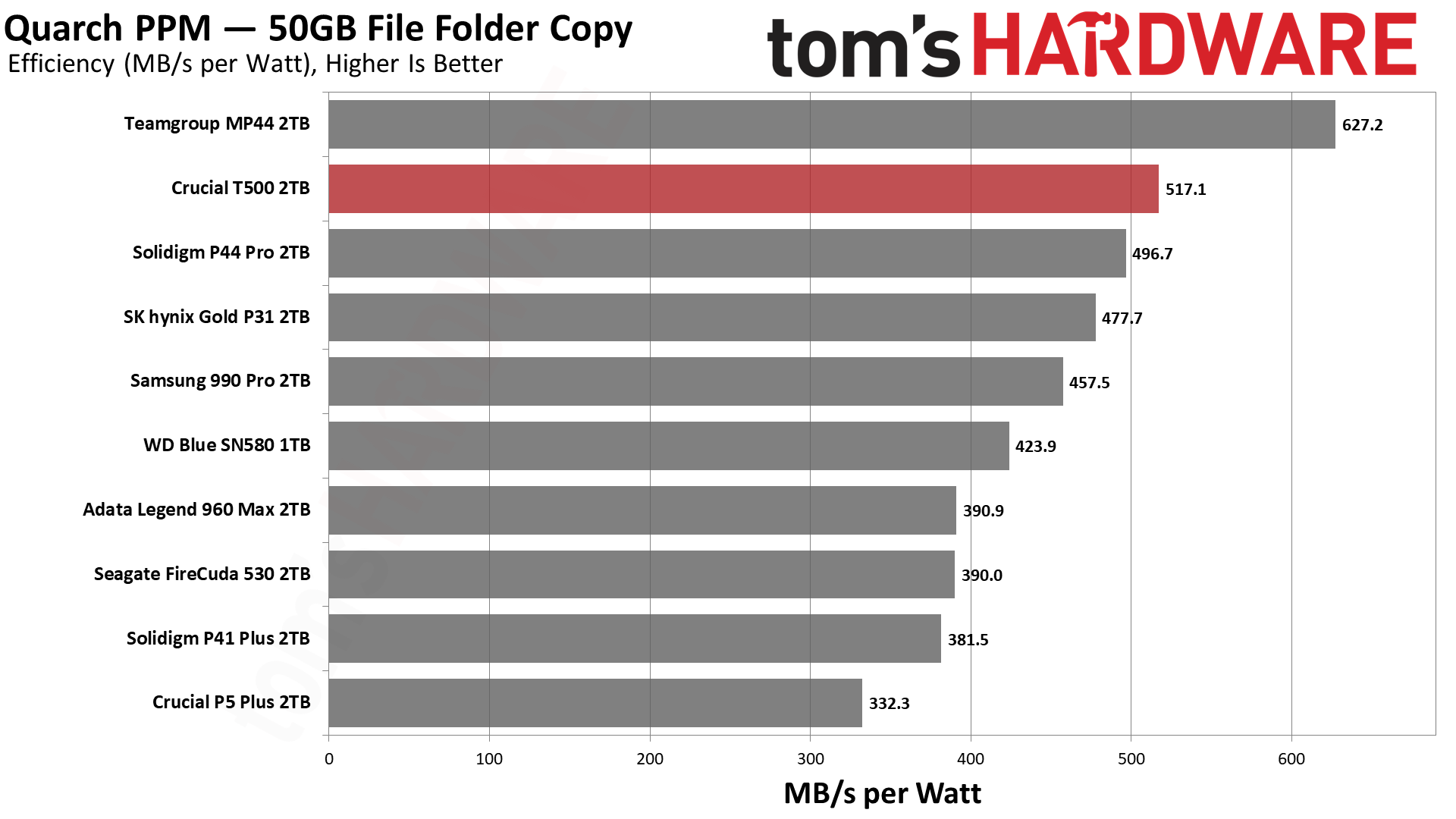



The T500 is quite efficient, certainly showing an improvement over the E18 on the FireCuda 530. It’s also more efficient than other high-end Gen 4 drives like the P44 Pro. It does fall short of the MP44, but that is to be expected. The T500 has DRAM while the MP44 is DRAM-less, and further, the T500’s E25 controller has more horsepower than the MP44’s MAP1602, gauging by peak IOPS. This places the T500 in a flexible position where it could replace several types of drives, from laptops to content creation, without any significant drawbacks. It’s more efficient than the legendary Gold P31 and would be even more so when run at PCIe 3.0 — finally, a worthy successor.
In testing, the T500 with heatsink hit a maximum temperature of 53C. Without the heatsink, we would expect a delta of 20C or less. These temperatures are well within a reasonable range: the drive’s first critical throttling state is reported to be at 86C, and there’s plenty of clearance for that. The controller’s metal IHS and greater surface area than the MAP1602 mean the T500 may dissipate heat more effectively under continuous load. While we had no problems with the MAP1602 drives overheating, the controllers could get pretty hot, so the T500 may be a safer bet.
Test Bench and Testing Notes
| CPU | Intel Core i9-12900K |
| Motherboard | Asus ROG Maximus Z790 Hero |
| Memory | 2x16GB G.Skill DDR5-5600 CL28 |
| Graphics | Intel Iris Xe UHD Graphics 770 |
| CPU Cooling | Enermax Aquafusion 240 |
| Case | Cooler Master TD500 Mesh V2 |
| Power Supply | Cooler Master V850 i Gold |
| OS Storage | Sabrent Rocket 4 Plus 2TB |
| Operating System | Windows 11 Pro |
We use an Alder Lake platform with most background applications such as indexing, Windows updates, and anti-virus disabled in the OS to reduce run-to-run variability. Each SSD is prefilled to 50% capacity and tested as a secondary device. Unless noted, we use active cooling for all SSDs.
Bottom Line
On the whole, we were pleasantly surprised by the Crucial T500. It managed very impressive performance numbers, matching the fastest Gen 4 drives we’ve tested with more horsepower than the “budget” contenders. It’s single-sided, has an affordable heatsink option, and is very efficient for its performance, considering it also has DRAM. This makes it feel more like a Gold P31 successor than a P5 Plus replacement: a drive that can work anywhere with few drawbacks. The P5 Plus’s claim to fame has been its low price, so we would like to see that here as well, and given the Gold P31’s main drawback was poor availability, we hope Crucial can overcome that, too.
The one question bound to be on your lips is: but what about 4TB? It has been challenging to get this flash at 4TB, at least with Phison’s controllers, which is disappointing. If you want high capacity at a good price without many drawbacks, drives like the A93 and NM790 are still great. They work for desktops, laptops, and the PS5, with or without a heatsink. However, for system drives that are usually 2TB or less, the T500 is very compelling with solid flash and an efficient, DRAM-equipped controller. DRAM is still a magical word in the SSD space, and this drive could end up really popular if it’s at all priced like the P5 Plus.
Other competing drives can be placed into three main groups: proprietary Gen 4, high-end Gen 4, and budget/mid-range Gen 4. Is this drive really a replacement for the 990 Pro, the P44 Pro, or the SN850X found in the first category? Not completely, but it has the advantage of a 500GB SKU, and it should be able to compete on price. For the second category, which includes a broad range of popular drives like the FireCuda 530 and Legend 960 Max, we think this drive is reminiscent of the Gold P31 with its ability to supplant older drives. If the T500 has good availability, it should be a safe pick, aside from sustained write workloads.
For the final category, with drives like the P3 Plus, we think those will remain attractive at 4TB for now, as QLC is best at delivering a good price-to-capacity ratio. There’s also the popular WD Black SN770 and Blue SN580, which work well for laptops and have aggressive pSLC caching rather than the small, static caches of previous Blue generations. We think the T500 can boost above these in almost every category while remaining single-sided thanks to its faster bus and newer flash. The heatsink option is nice, too, making it the drive to beat for a drop-in system drive within its capacity range.
The one downside is, of course, the inconsistent sustained performance. This is not a huge factor on its own, as sustained writes of such a large size are very uncommon. Such a scenario is more likely when a drive is filled since the cache will be fuller, but Crucial states it uses a hybrid cache, static and dynamic. The static portion should ensure more consistent full-drive performance. That said, it’s clear some work has to be done on managing the dynamic portion, which we are hopeful that Crucial will address quickly in firmware.
All-in-all, we think the T500 is a great addition to Crucial’s SSD lineup. The P5 Plus can fade away as a last-gen, budget-oriented model, maybe sticking around a while longer as a less expensive option in the stack. That does leave the T500 in a tougher place on pricing, but Crucial appears to be already fine-tuning the MSRP, and Black Friday is just around the corner. The company has historically been aggressive on pricing, so we think the T500 could become very popular. There will certainly be better drives to come in the long-term, especially at 4TB, but if you’re looking for a Gold P31 substitute — even if you’re still on a Gen 3 machine! — we think this is the closest we’ve seen, and that’s not faint praise.
MORE: Best Hard Drives
MORE: Best SSDs
MORE: How We Test HDDs And SSDs

Shane Downing is a Freelance Reviewer for Tom’s Hardware US, covering consumer storage hardware.
-
waltc3 Always want to point out that the so-called endurance numbers are far less important than the warranty period for all of these NVMe drives. If the drive craps out at 400TB written, but you are 7 years along, too bad...;) Most vigorous usage for these drives might cap out as high as 150TB-200TB in five years, so I only look at the warranty period when I buy an NVMe drive--the longer it is the better. I'm still using a SS 960 EVO 256-GB NVMe I bought ~ 4 years ago, and it's still sitting on 21TBs written, and the first 18 months or so it was my boot drive, which saw a lot of writing through beta OS installs. Today it runs games, while my boot drive is an SS 980 Pro sitting on 31Tb written. Interesting that the "endurance" number for the 960 EVO is 75TBs, and after 4+ years of constant use I'm not anywhere near that...;) BTW, I use my system for 8-12 hours a day. So, yeah...;)Reply -
dimar What's the deal with TBW? It keeps going down with newer models.. Shouldn't they make improvement with TBW before moving to higher speeds?Reply -
Makaveli Reply
yup seems as the flash gets faster the endurance is less.dimar said:What's the deal with TBW? It keeps going down with newer models.. Shouldn't they make improvement with TBW before moving to higher speeds?
My Gen 1 Corsair MP600 has 1,800 TBW
All of the Newer 1TB drives are at 600 TBW
And even the 2TB drives are at 1200 TBW -
JarredWaltonGPU Reply
The thing is, realistically, no one (as a regular consumer) should ever come anywhere near the TBW figures. Like, I have a desktop PC that I've been using for 3.5 years, with a 2TB SSD. I've used it A LOT, installing and deleting games, filling it up and deleting stuff, etc. After that much time, it currently has 175 TB of total writes, according to CrystalDiskInfo. It's rated for 1280 TBW, so I'm not even 15% of the way through the endurance.Makaveli said:yup seems as the flash gets faster the endurance is less.
My Gen 1 Corsair MP600 has 1,800 TBW
All of the Newer 1TB drives are at 600 TBW
And even the 2TB drives are at 1200 TBW
And the SSD is now "slow" compared to modern stuff. By the time it's five years old, I'll definitely be thinking about retiring the PC, or maybe putting in a larger SSD. Basically, outside of QLC (which has much worse endurance than TLC), you really have try very, very hard to hit the endurance rating within five years.
As another example, I have a 2TB Samsung 850 Pro SATA SSD. That means I've had it about eight years (!), and while I've stored plenty of stuff on it, I haven't hit it nearly as hard as the OS drive. SMART says it currently has 161TB of writes. Funny thing is, being from 2015, it's only rated for 300TBW. Still, I'm only at a bit more than half it's endurance, and it is very much just slow backup storage for me these days. -
Makaveli Reply
I agree most of us don't come close to that in normal desktop usage.JarredWaltonGPU said:The thing is, realistically, no one (as a regular consumer) should ever come anywhere near the TBW figures. Like, I have a desktop PC that I've been using for 3.5 years, with a 2TB SSD. I've used it A LOT, installing and deleting games, filling it up and deleting stuff, etc. After that much time, it currently has 175 TB of total writes, according to CrystalDiskInfo. It's rated for 1280 TBW, so I'm not even 15% of the way through the endurance.
And the SSD is now "slow" compared to modern stuff. By the time it's five years old, I'll definitely be thinking about retiring the PC, or maybe putting in a larger SSD. Basically, outside of QLC (which has much worse endurance than TLC), you really have try very, very hard to hit the endurance rating within five years.
As another example, I have a 2TB Samsung 850 Pro SATA SSD. That means I've had it about eight years (!), and while I've stored plenty of stuff on it, I haven't hit it nearly as hard as the OS drive. SMART says it currently has 161TB of writes. Funny thing is, being from 2015, it's only rated for 300TBW. Still, I'm only at a bit more than half it's endurance, and it is very much just slow backup storage for me these days.
This is my host writes on the MP600 been in use since Dec 2019 as an OS drive until recently replaced by my 850X
WD SN850X purchased in august as new OS drive.
-
Amdlova For OS I use a intel optane 280gb :) will last forever. For other things solidgm ssd with drivers from solidmReply -
Sleepy_Hollowed If this drive has their previously excellent power-loss safety features, this would be a go-to drive for consumers that care about that.Reply
It's hard to test and the only people that care about that are those using it for work, school or both, but Crucial's top end drives used to be top notch for consumers even amongst premium brands, and they saved me more than once. -
Makaveli Will be curious to see how this drive is in a few months after a couple firmware updates and price drops.Reply -
Not_Available I'm part of Amazon Vine, which is a group of customers who can order a lot of items for "free" in order to review them. For tax purposes companies must give a "fair market value" for their products. (We pay income tax based on that)Reply
Crucial listed the fair market value for the Crucial T500 2TB (with heatsink) at $156.95. So I'd expect the first few sales to be around there. -
NWCherokee Does the T500 have 256 AES hardware encryption support (SED self encrypting drive) that would allow it to use hardware encryption with Windows bitlocker? Or is it strictly OPAL encryption only?Reply
